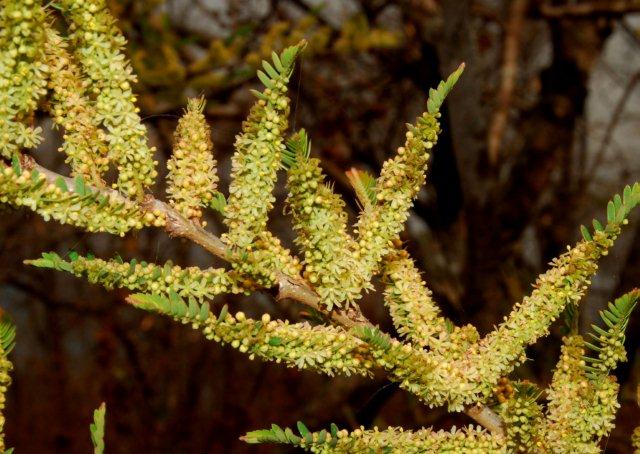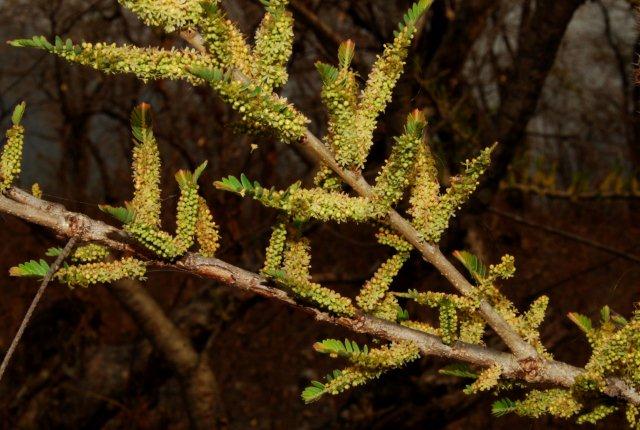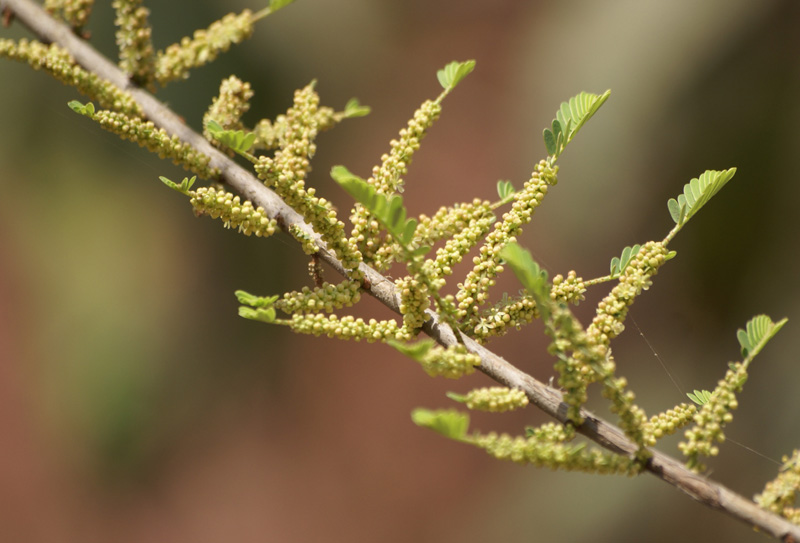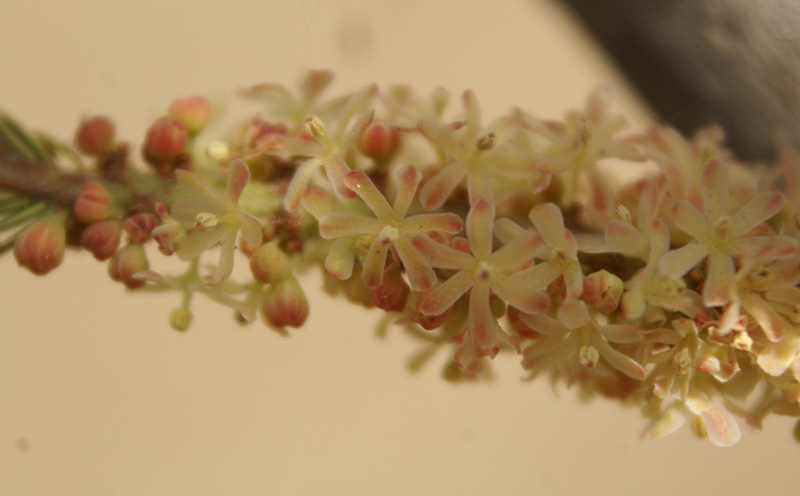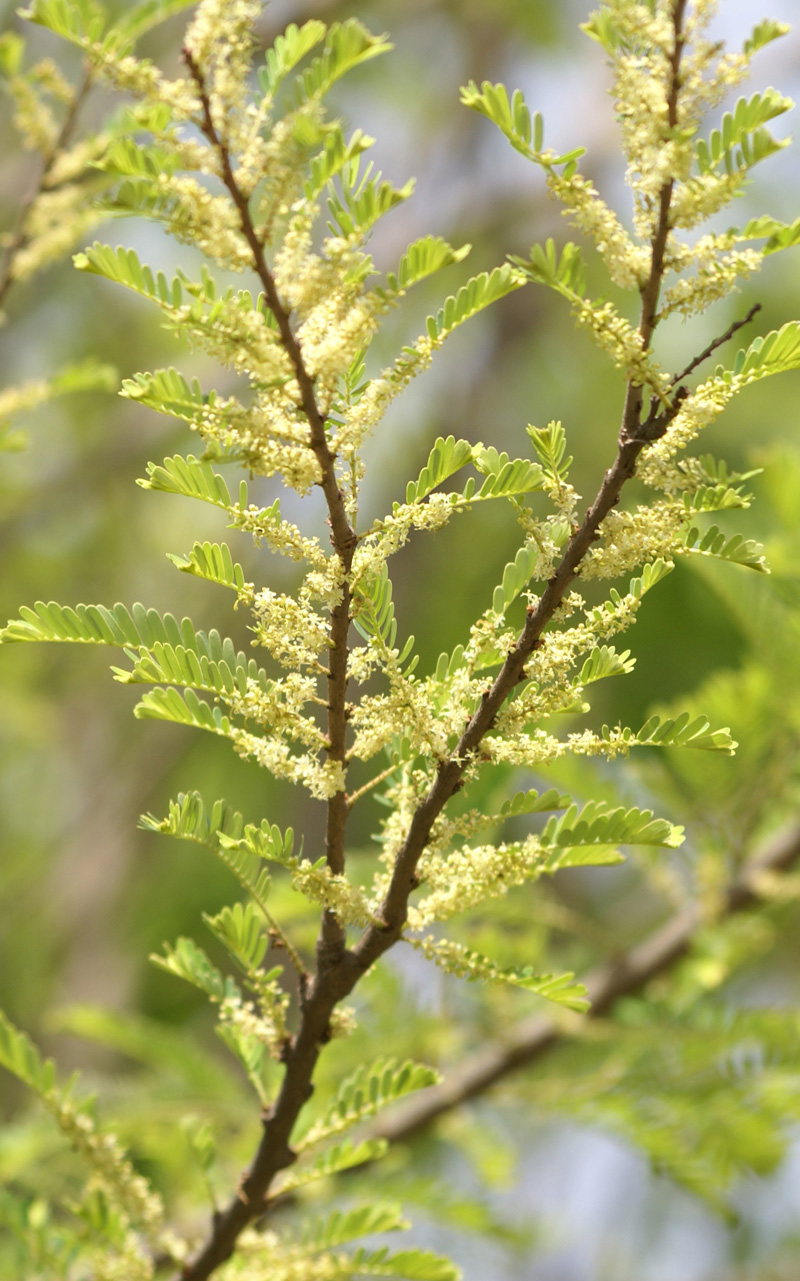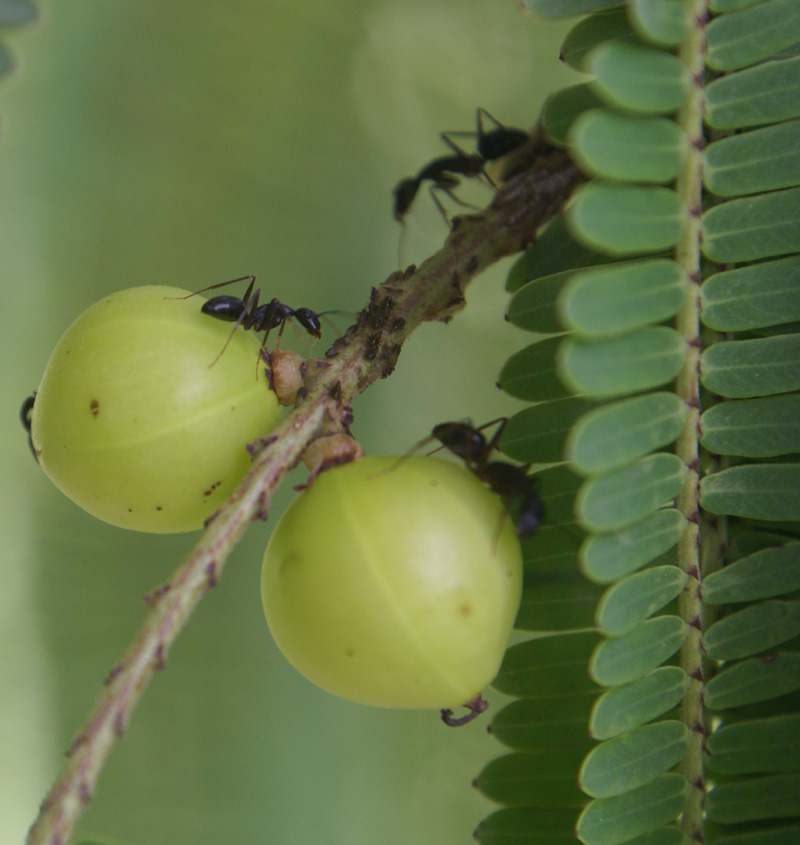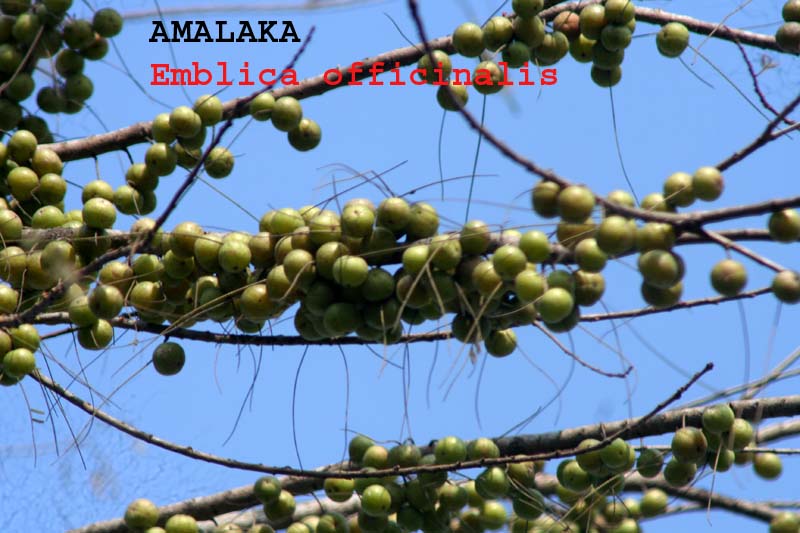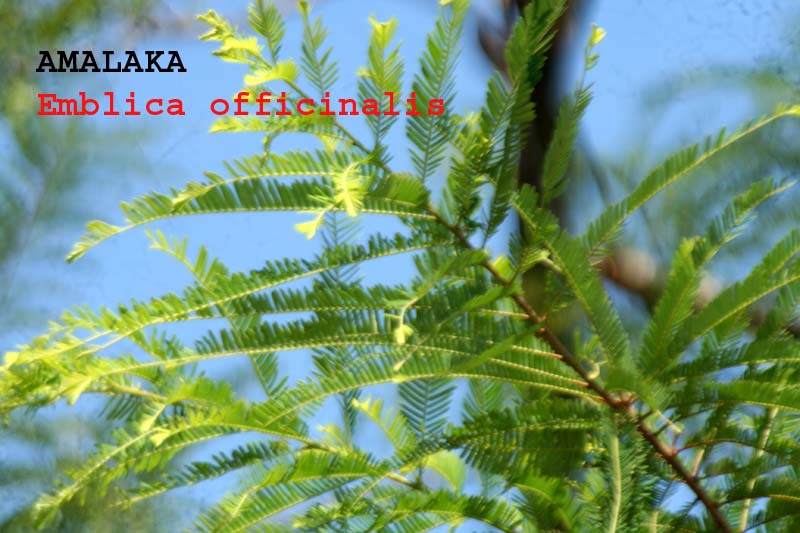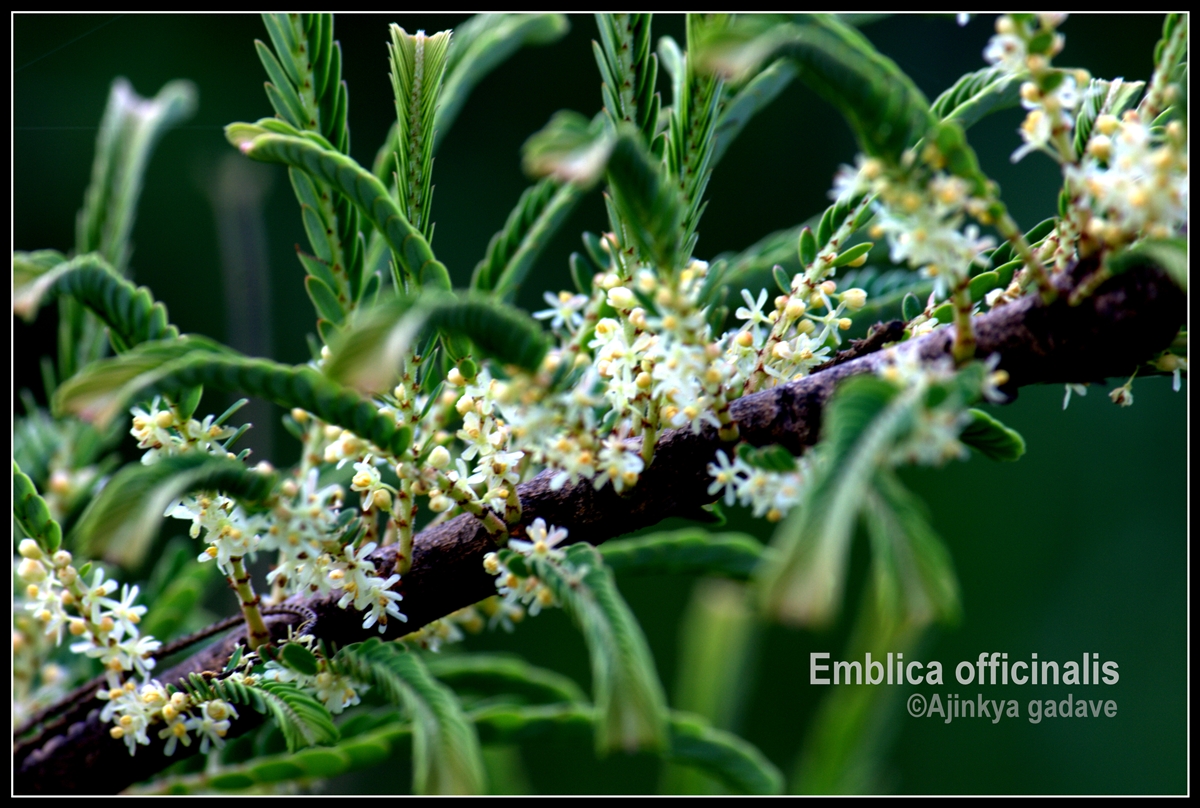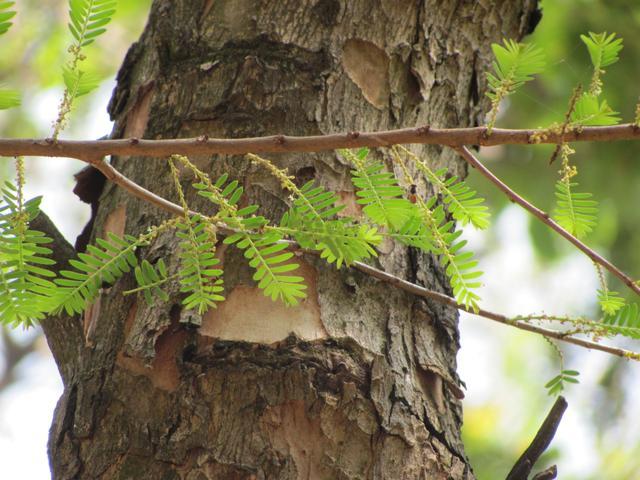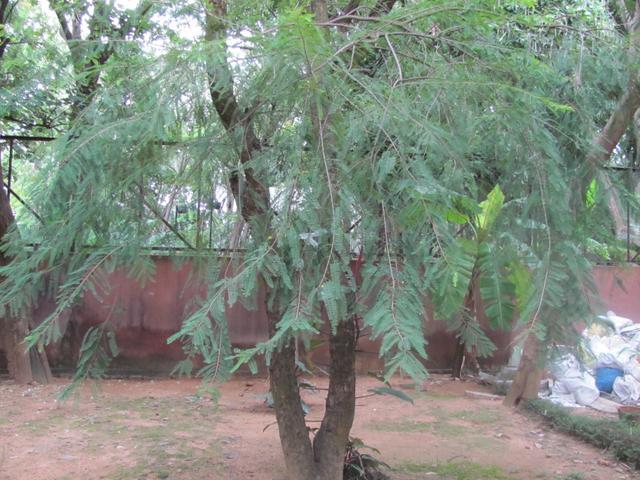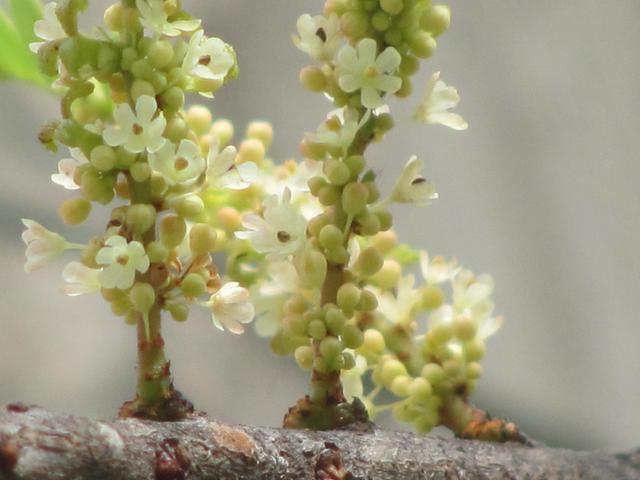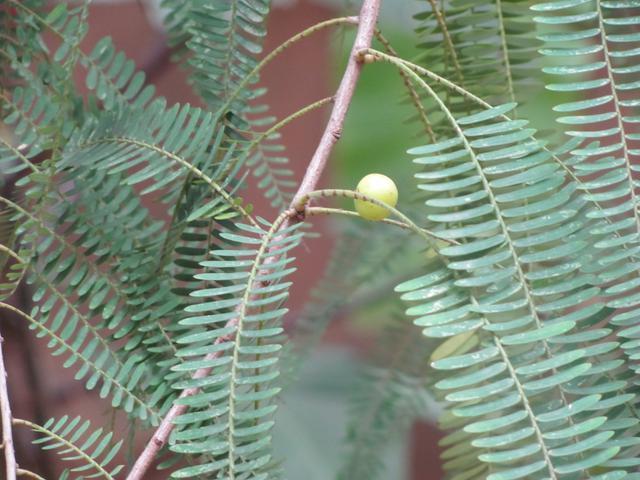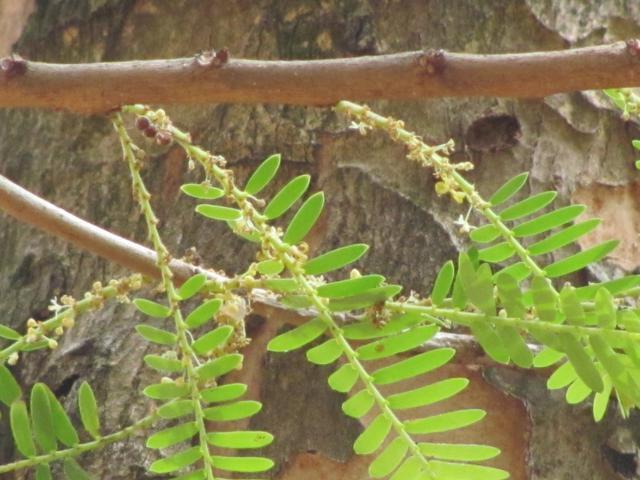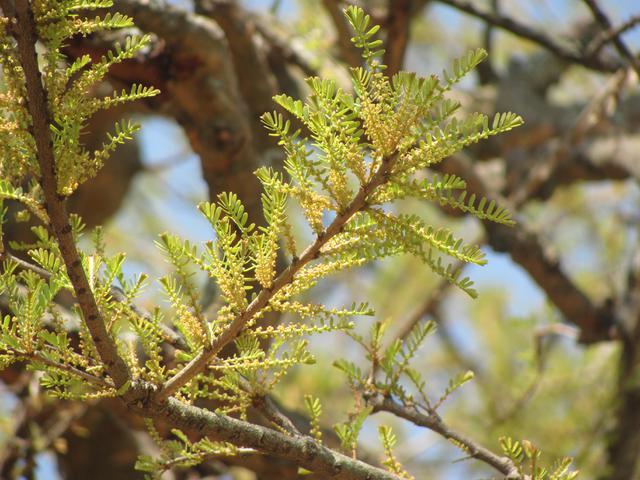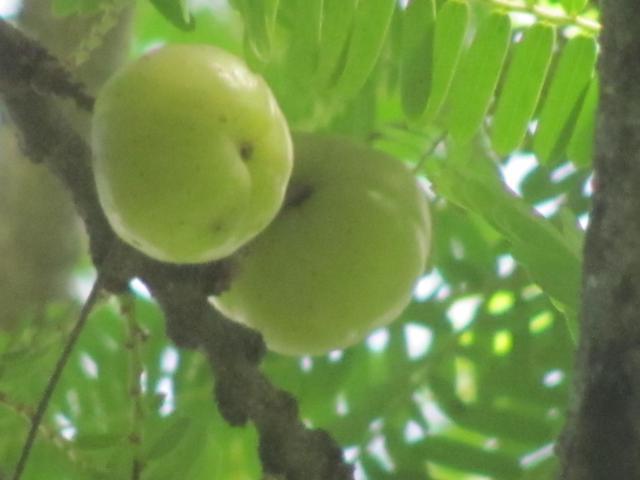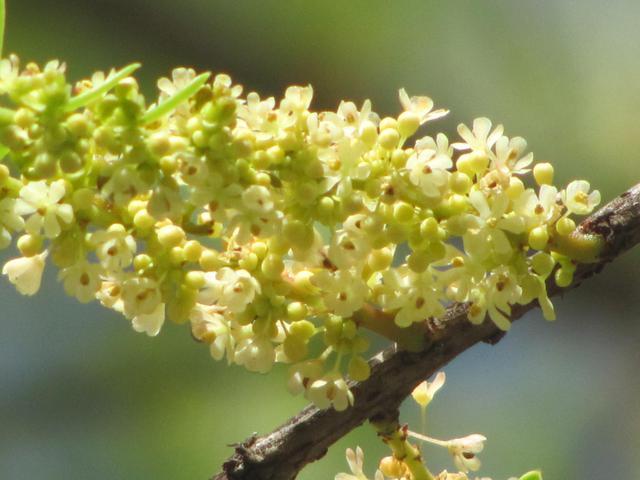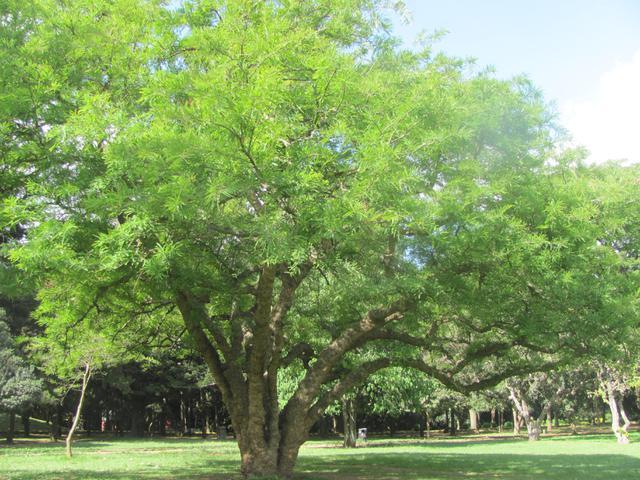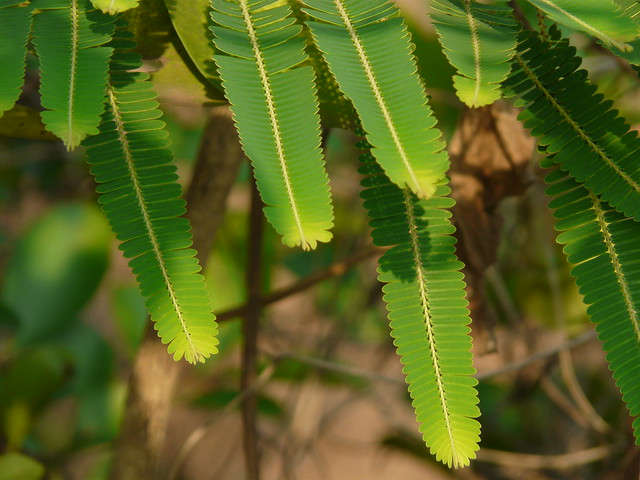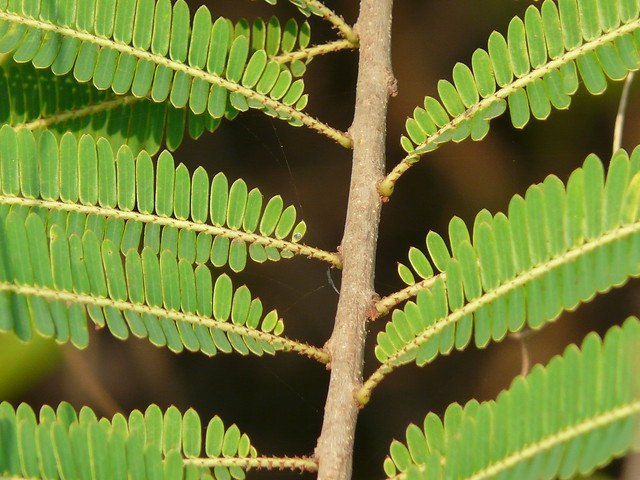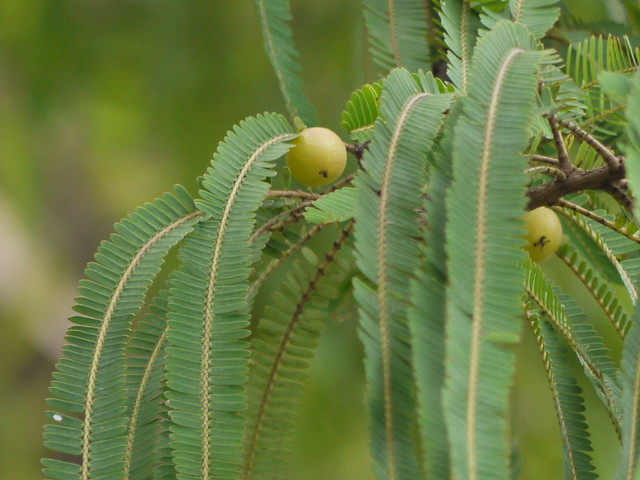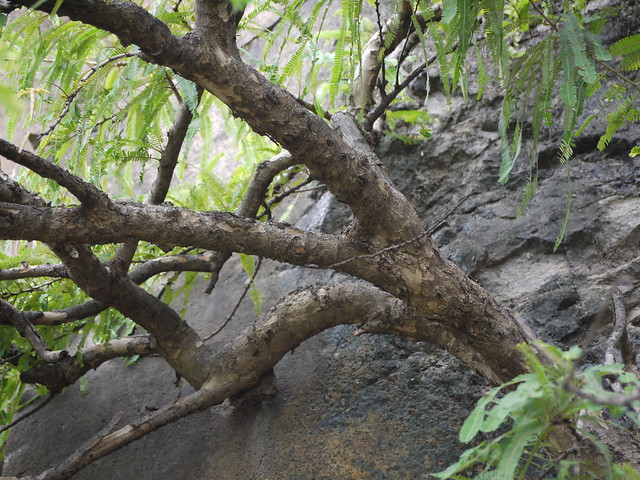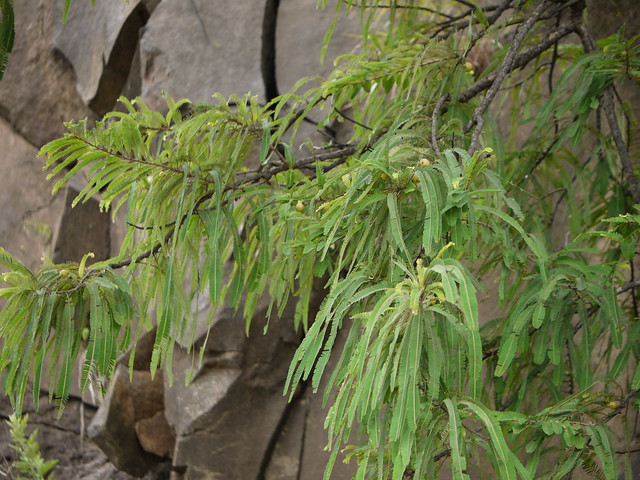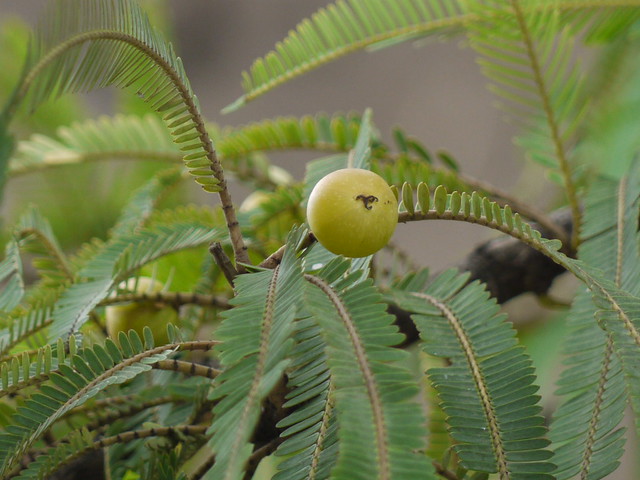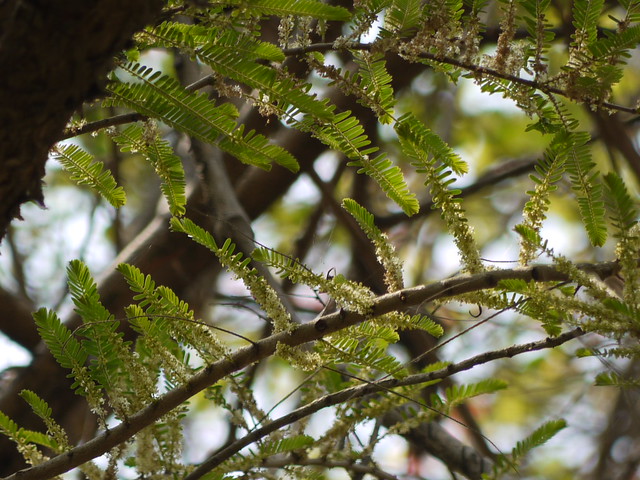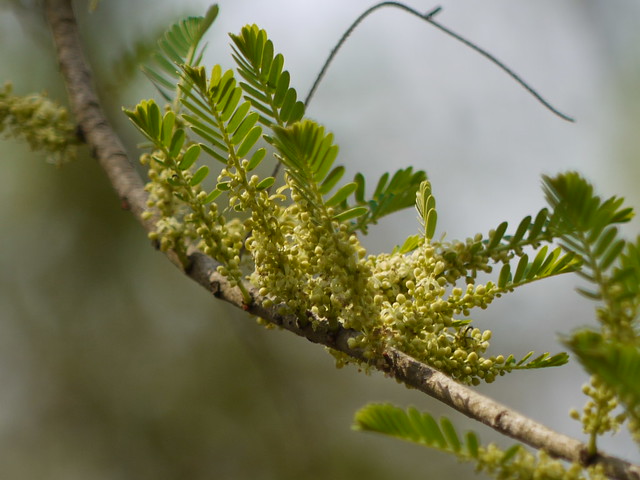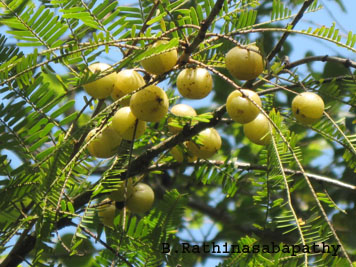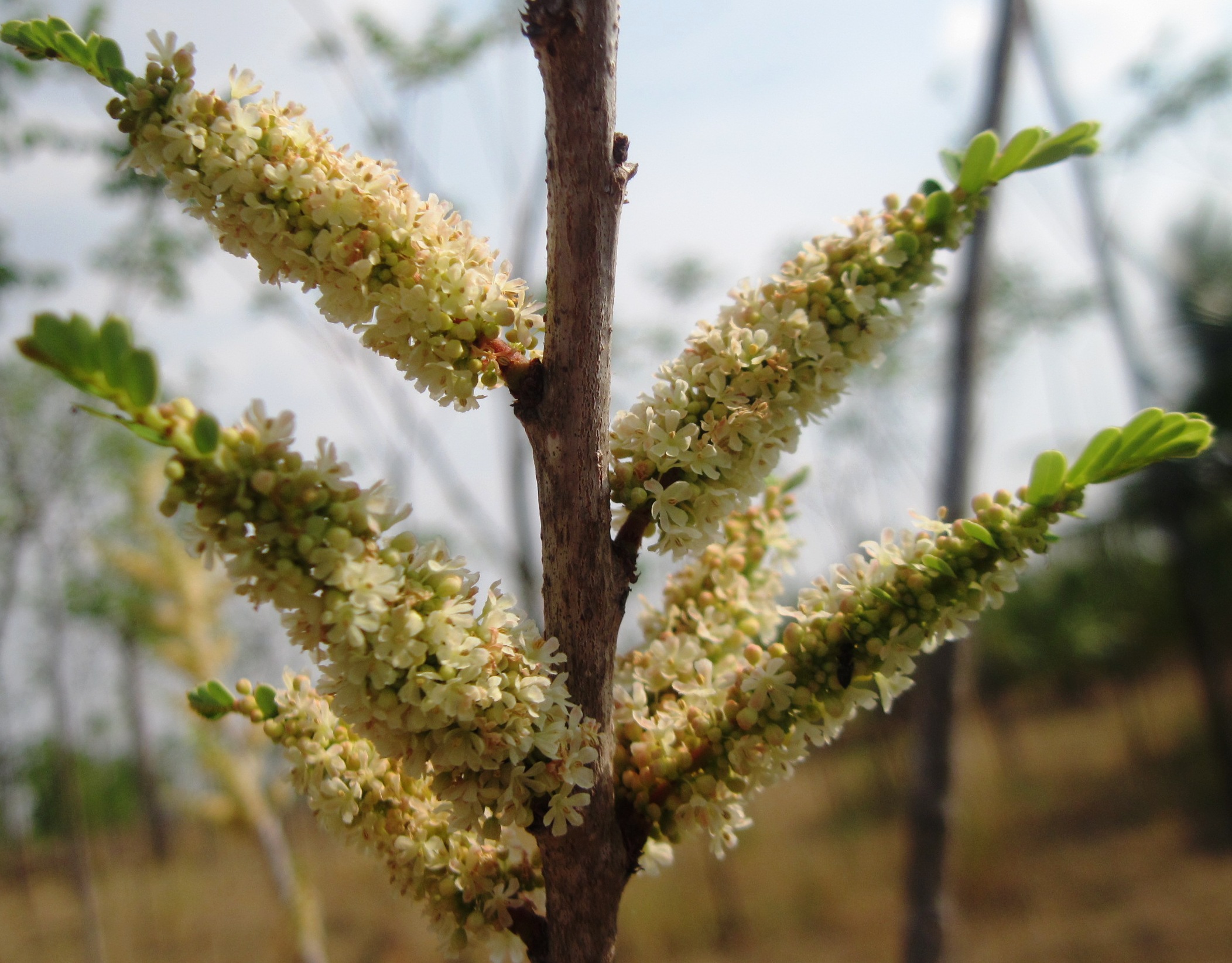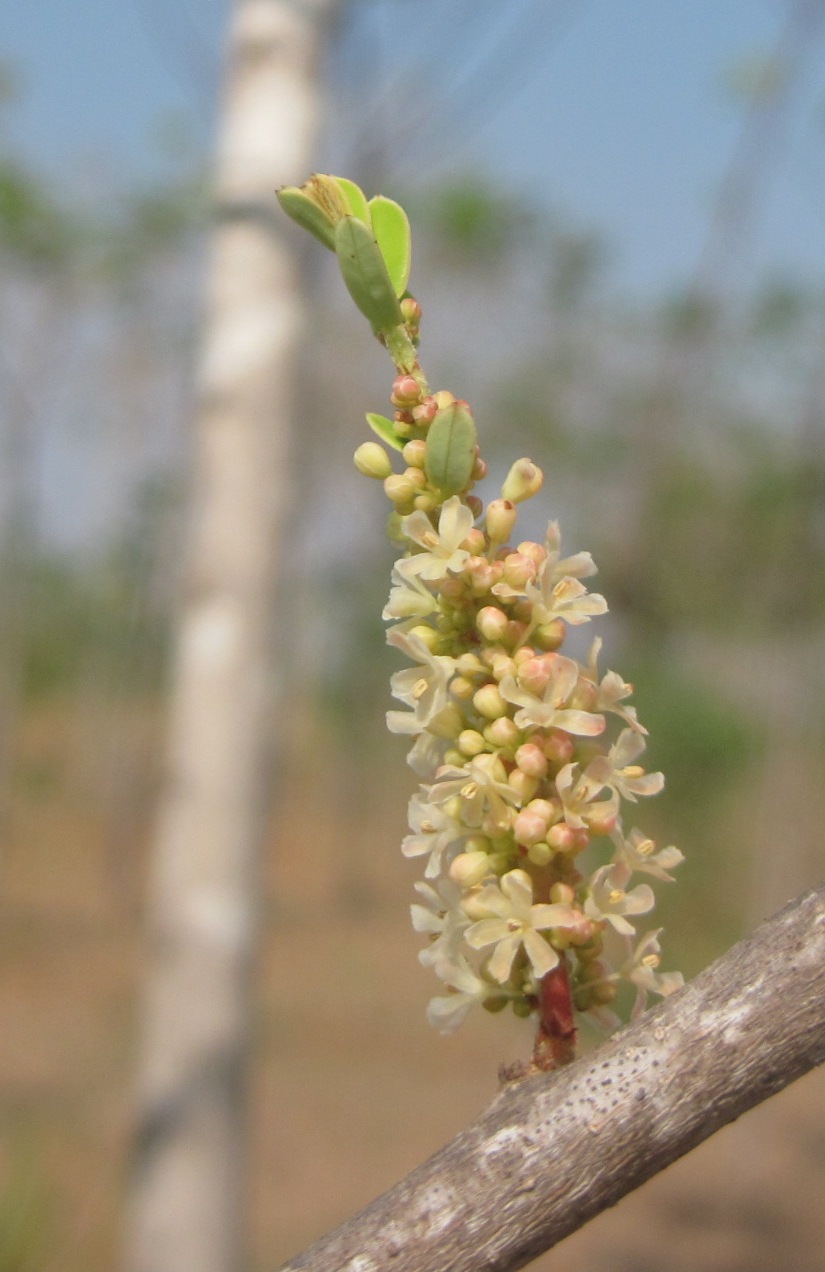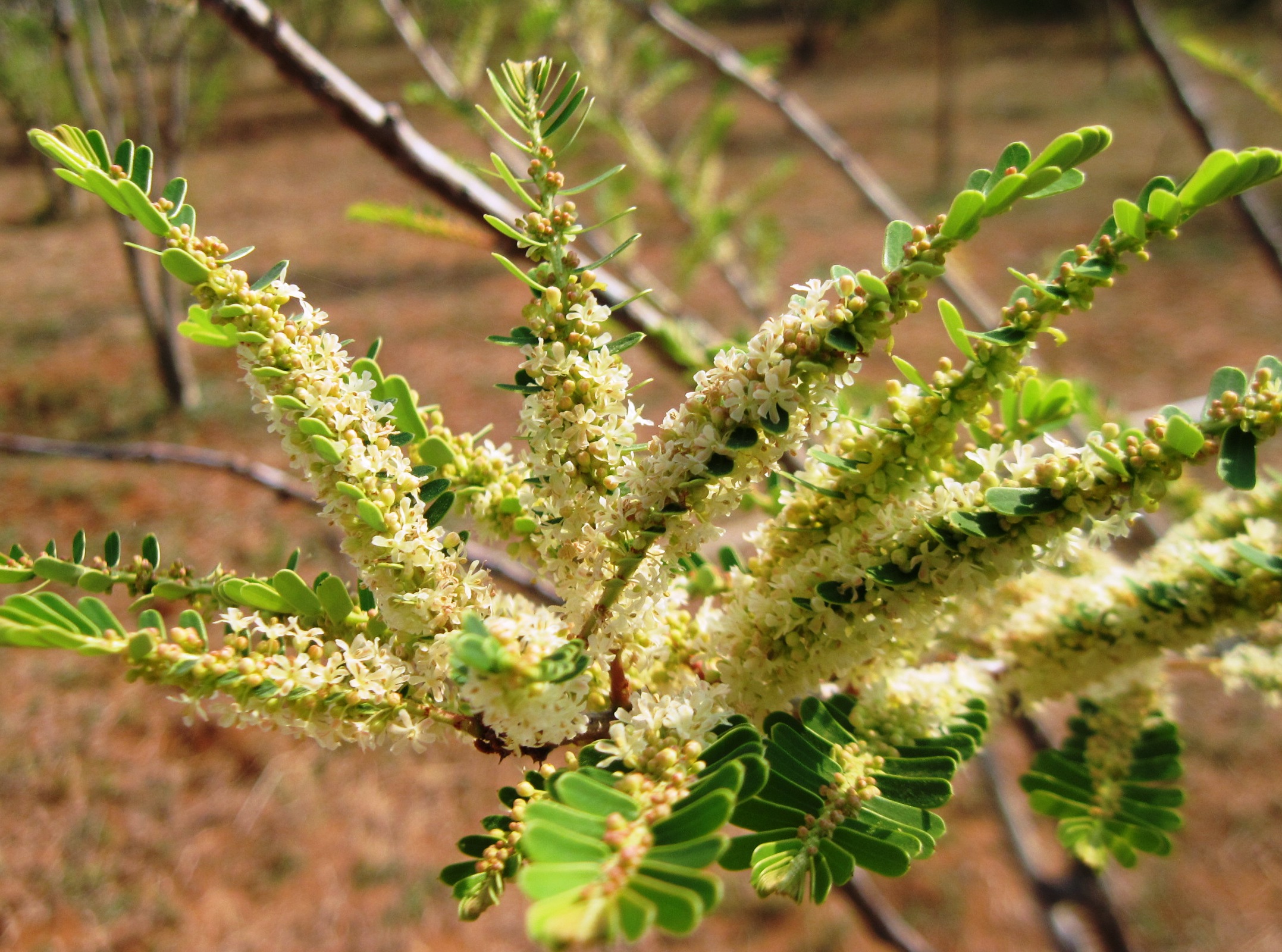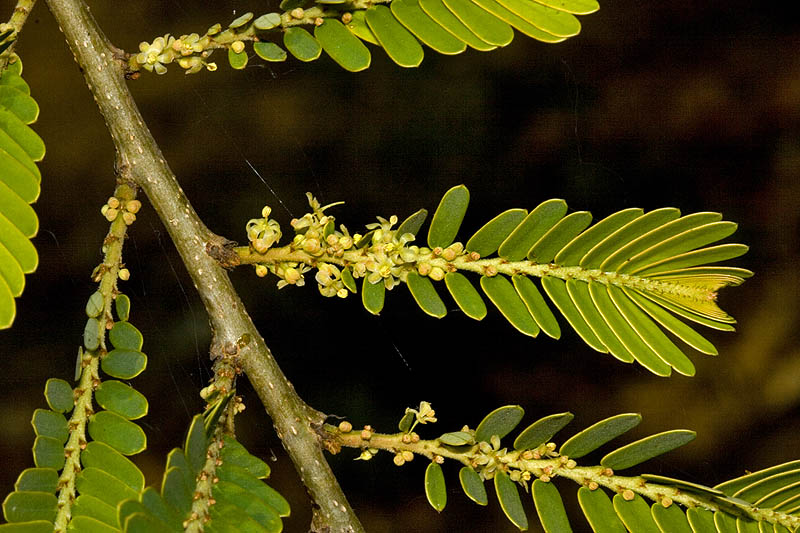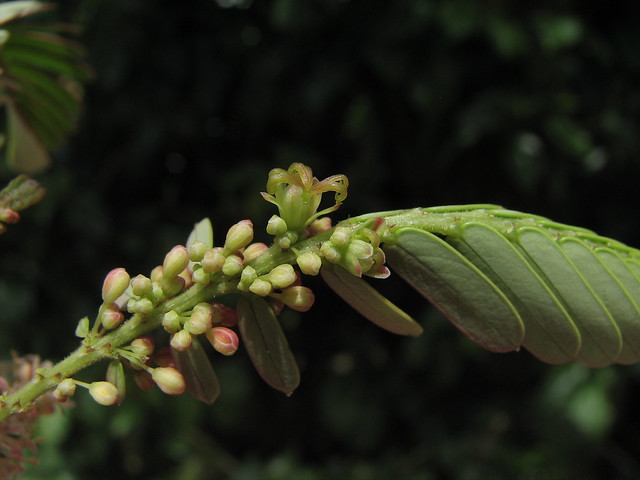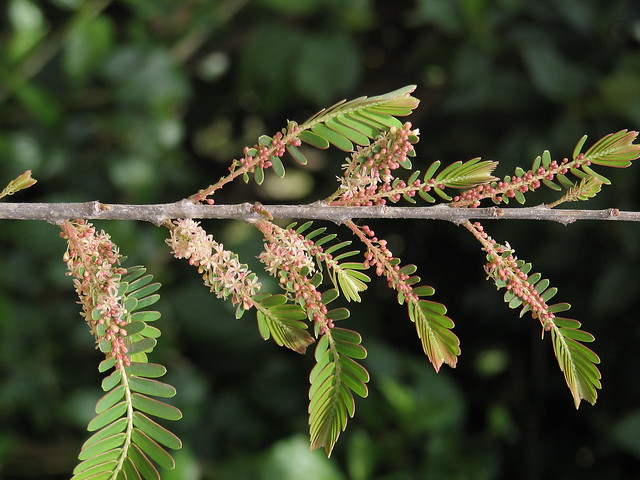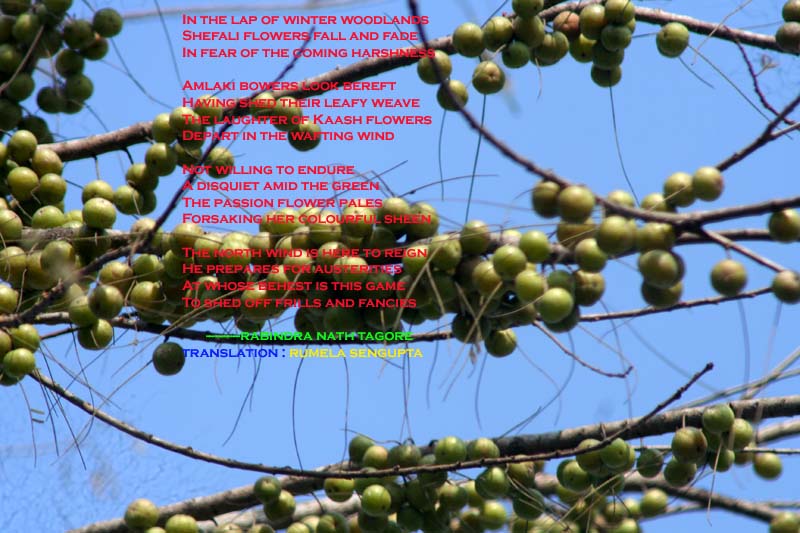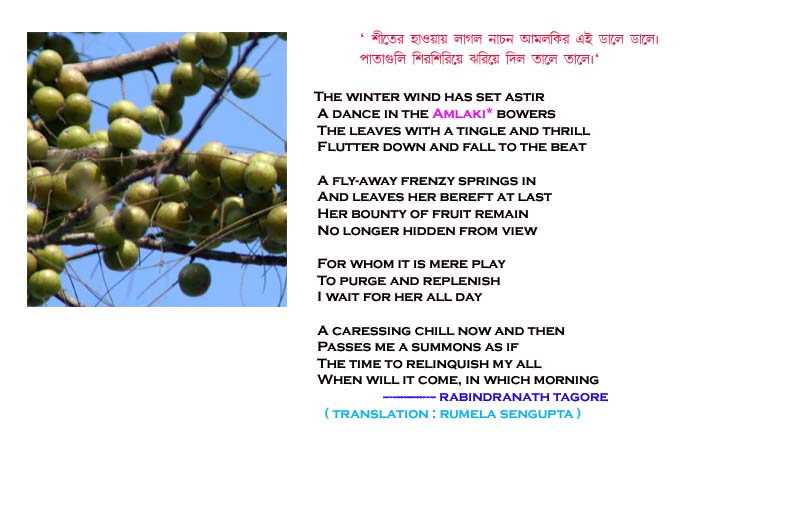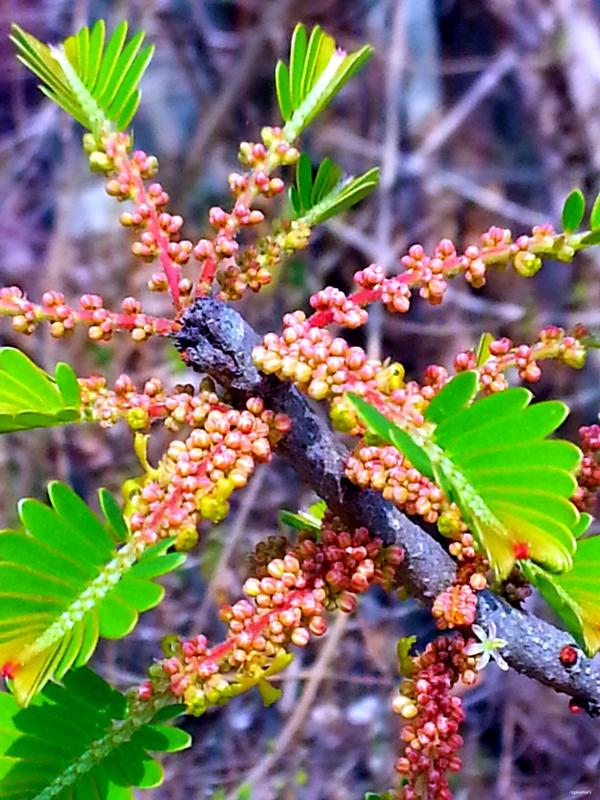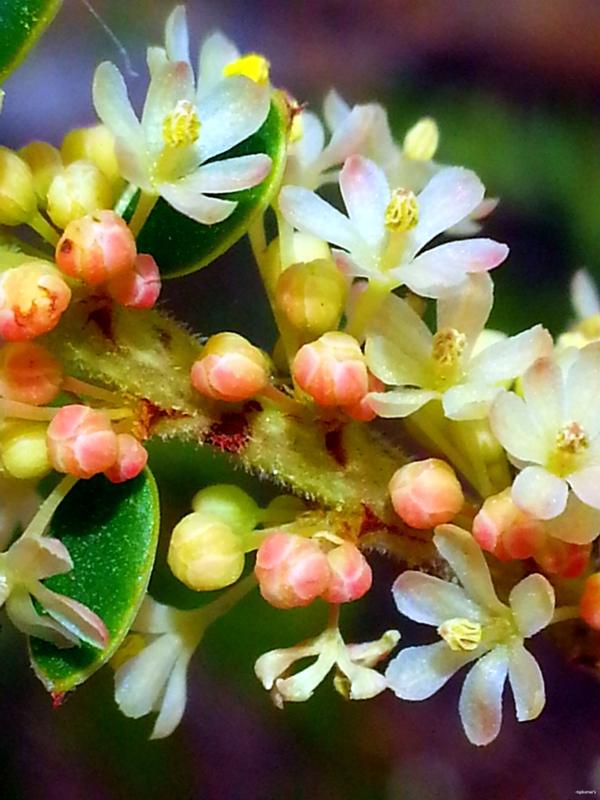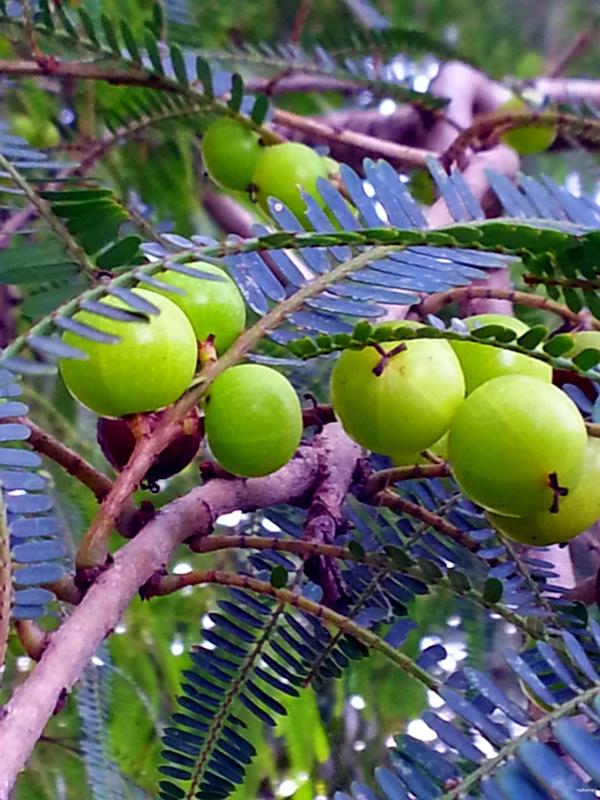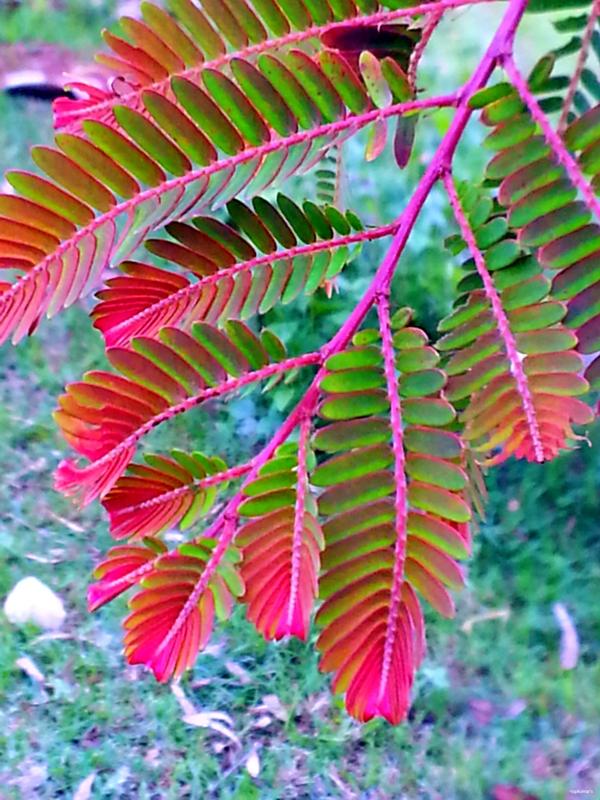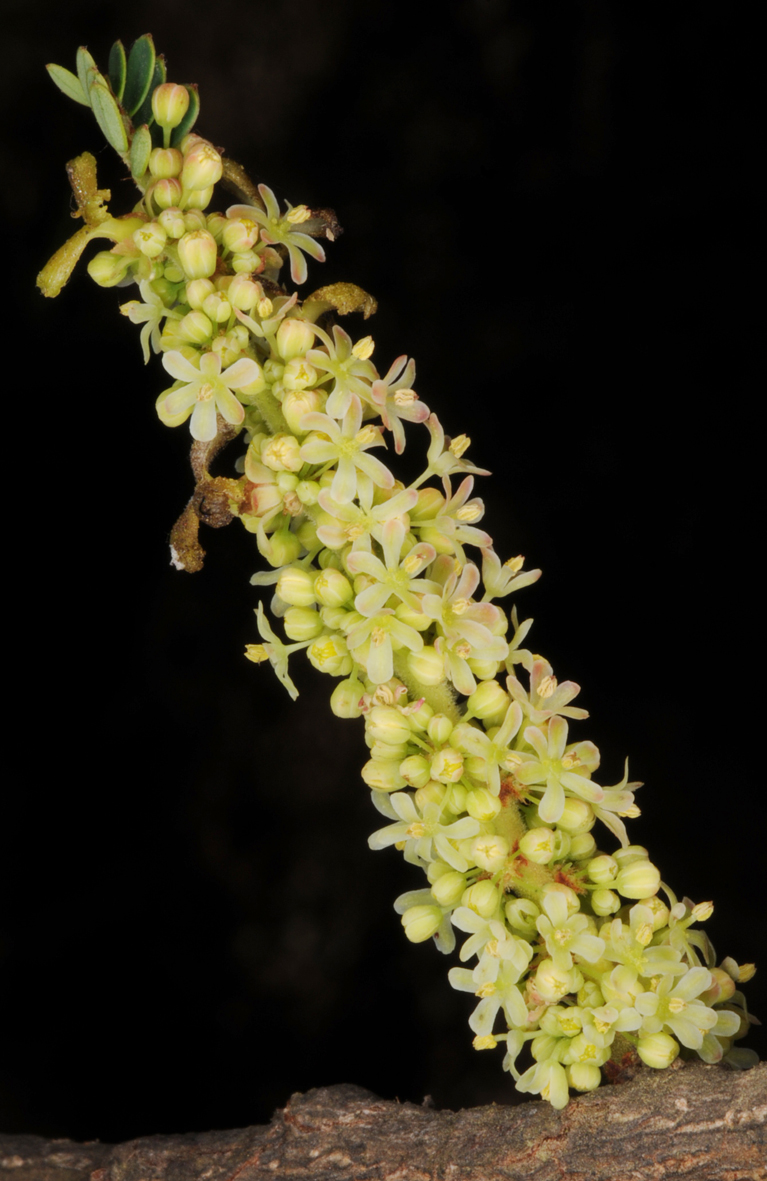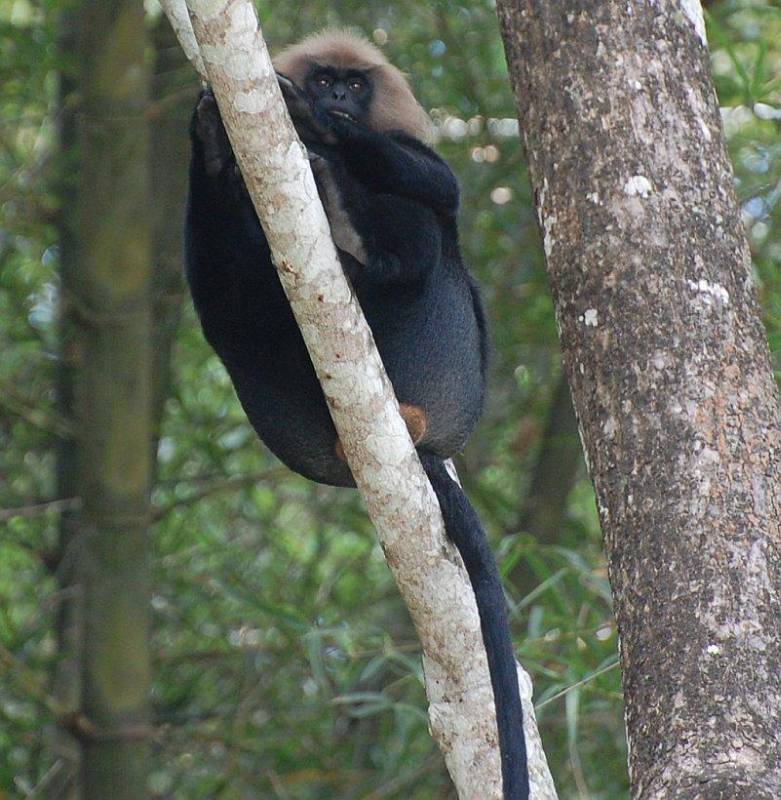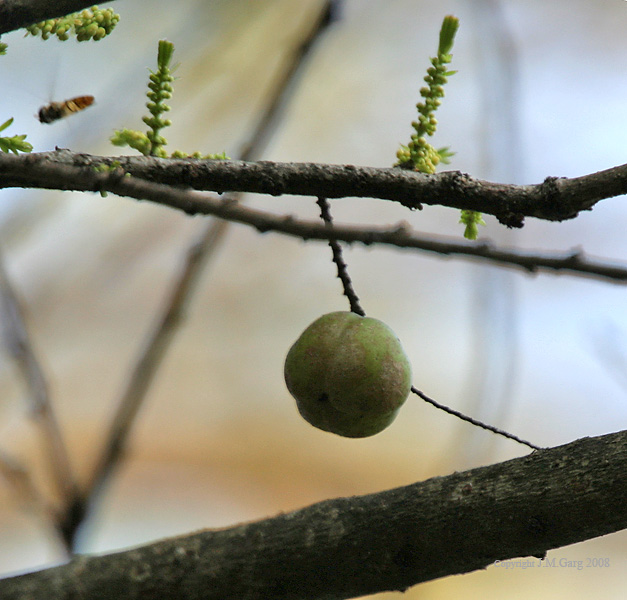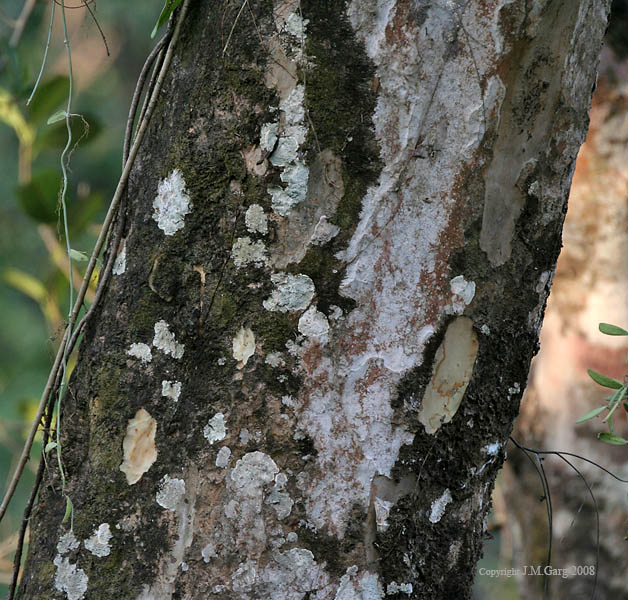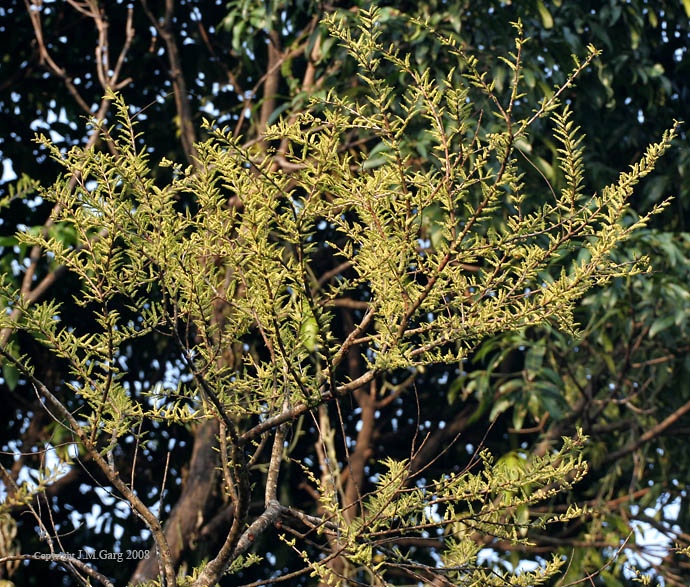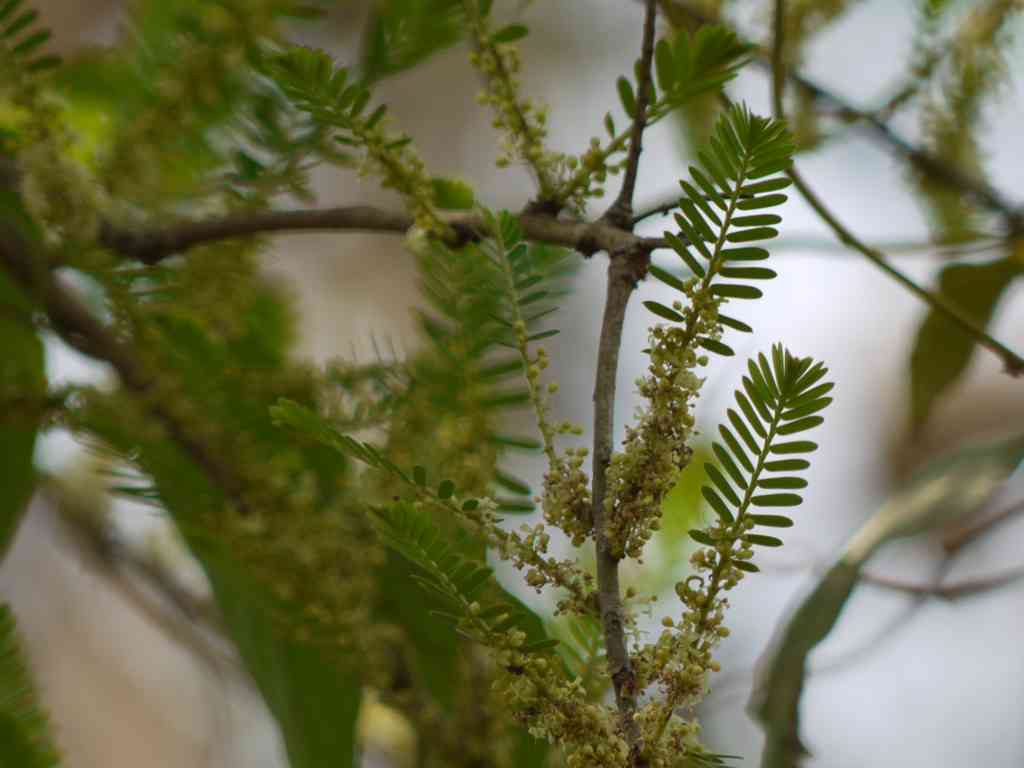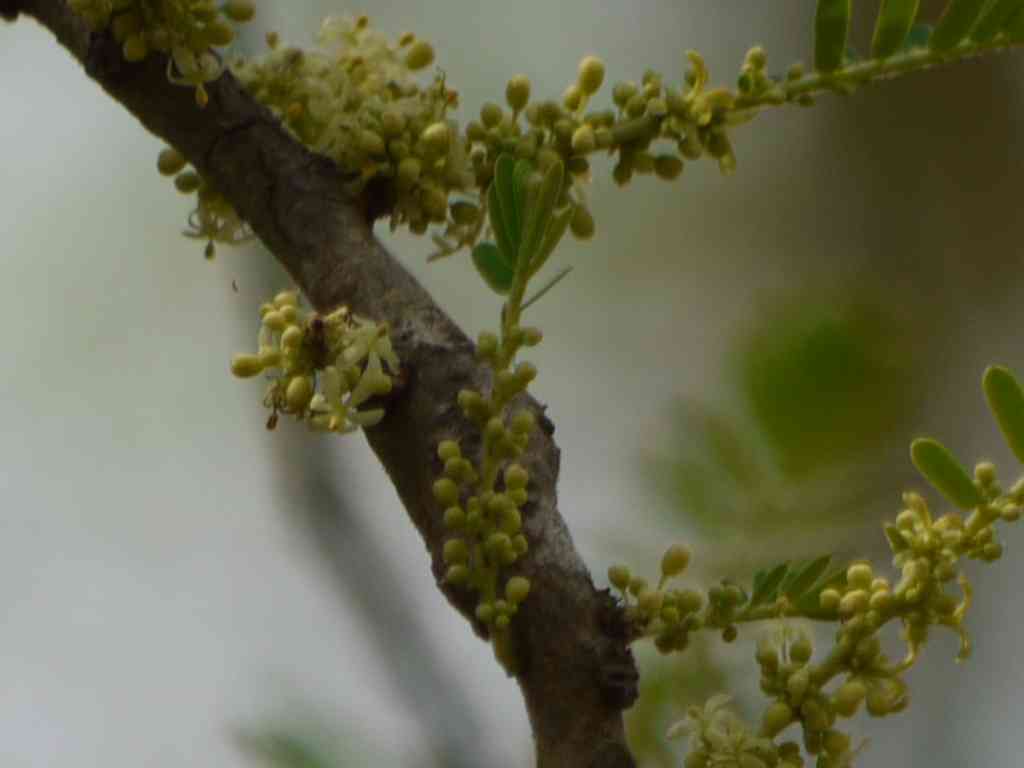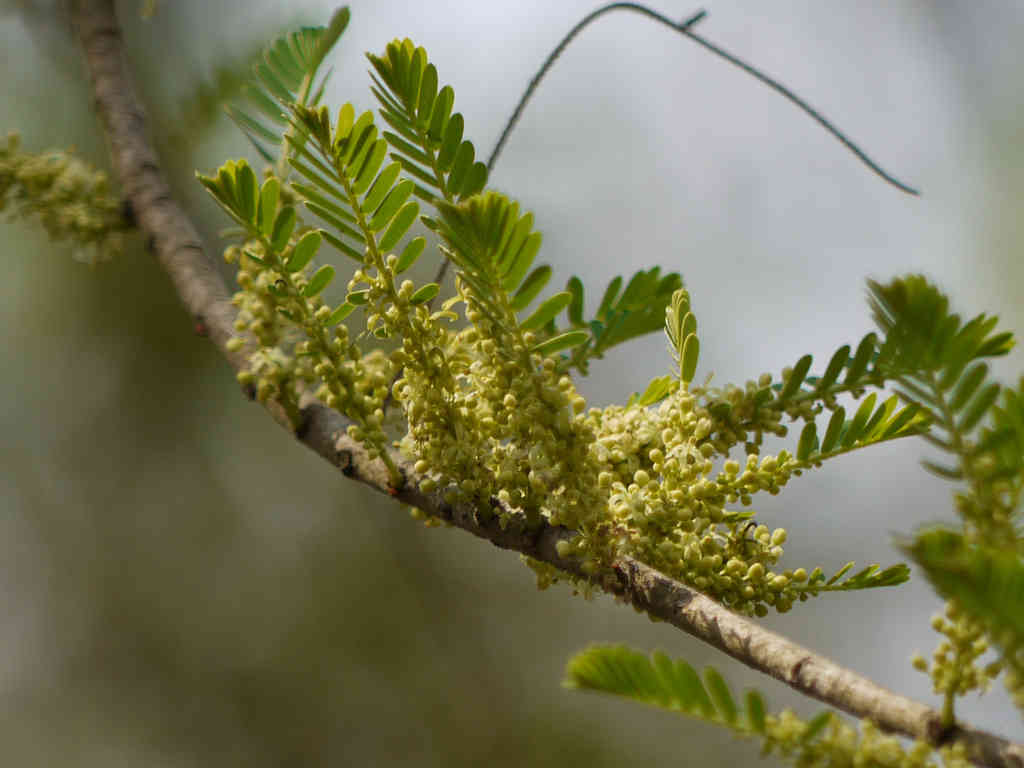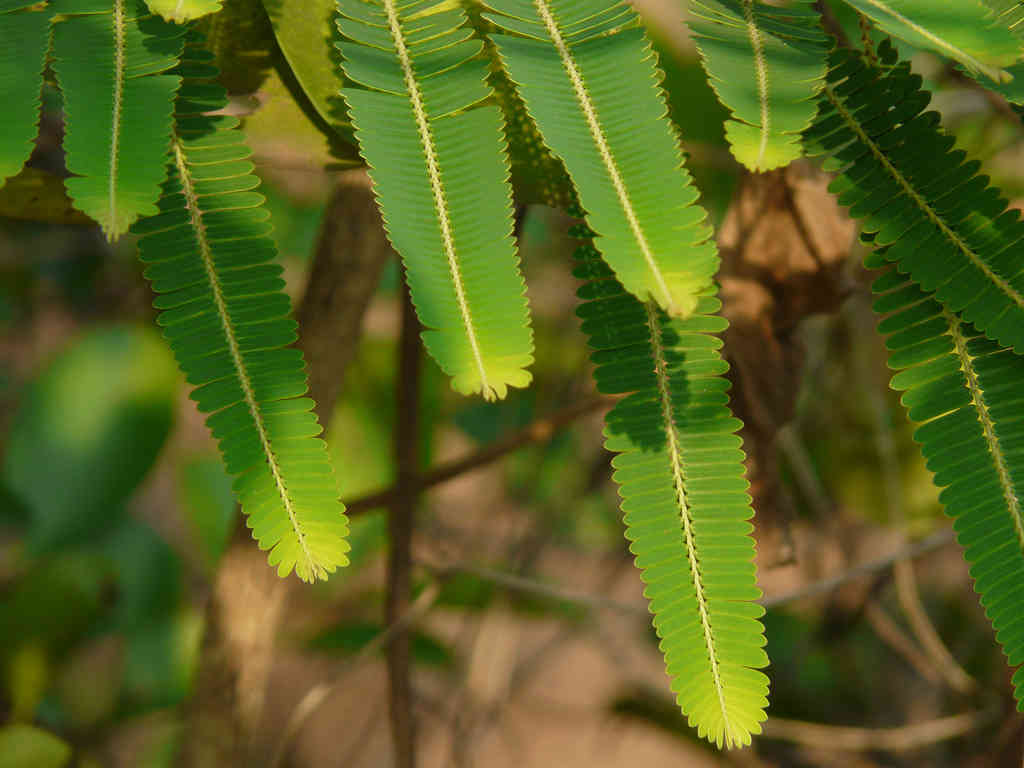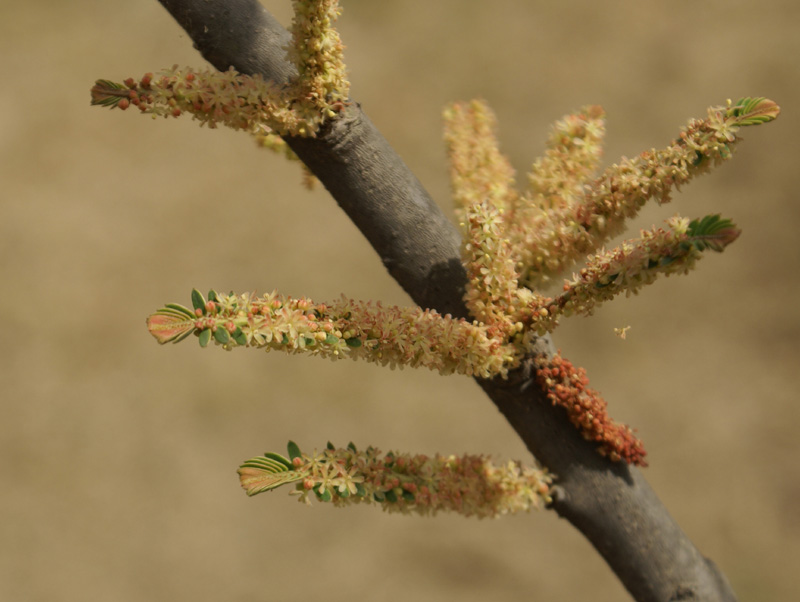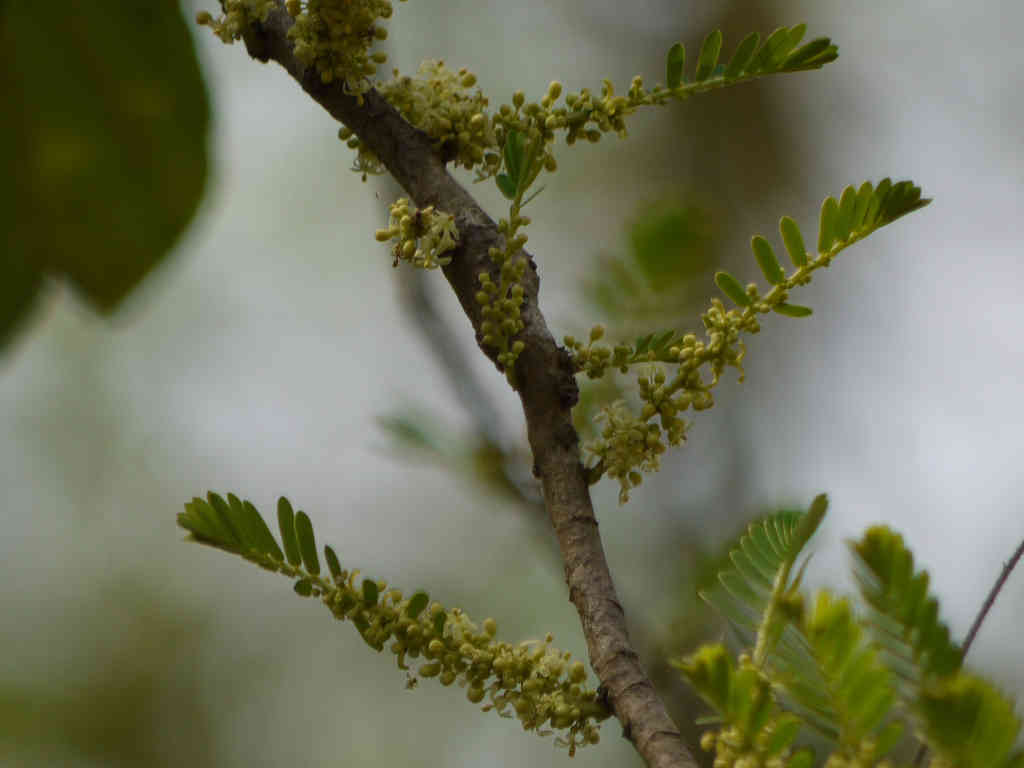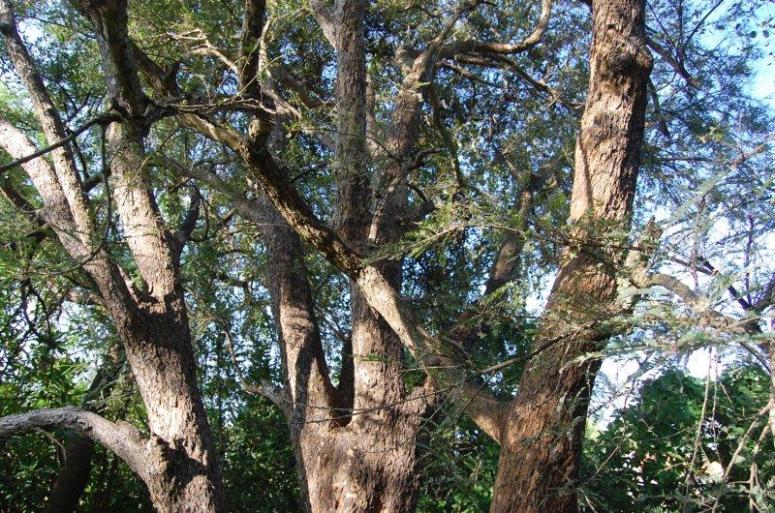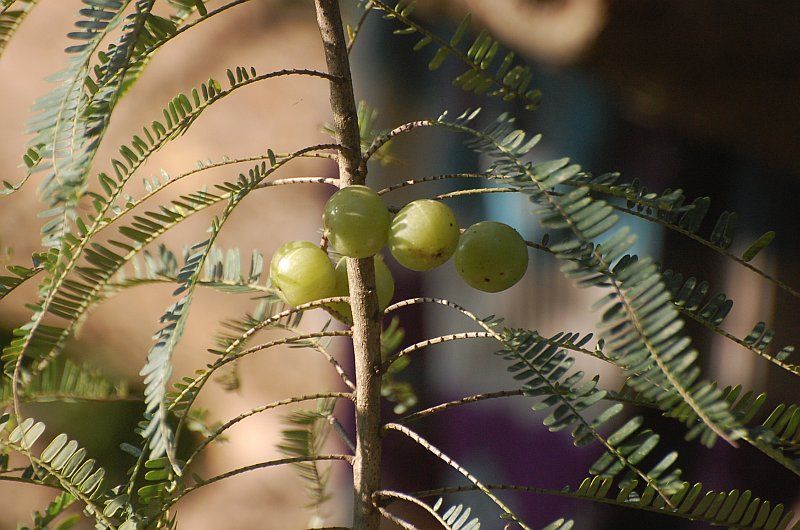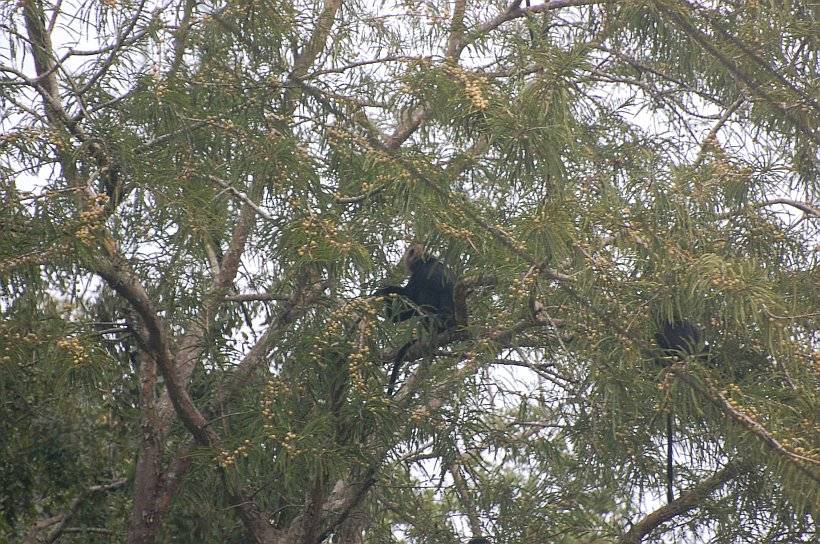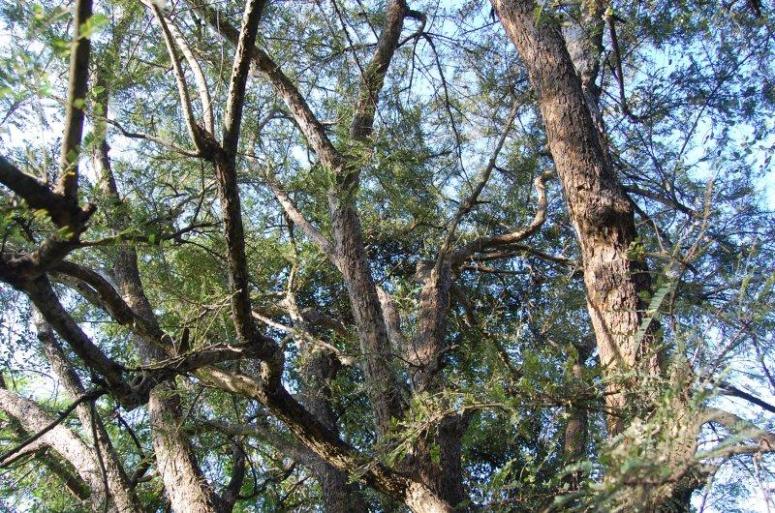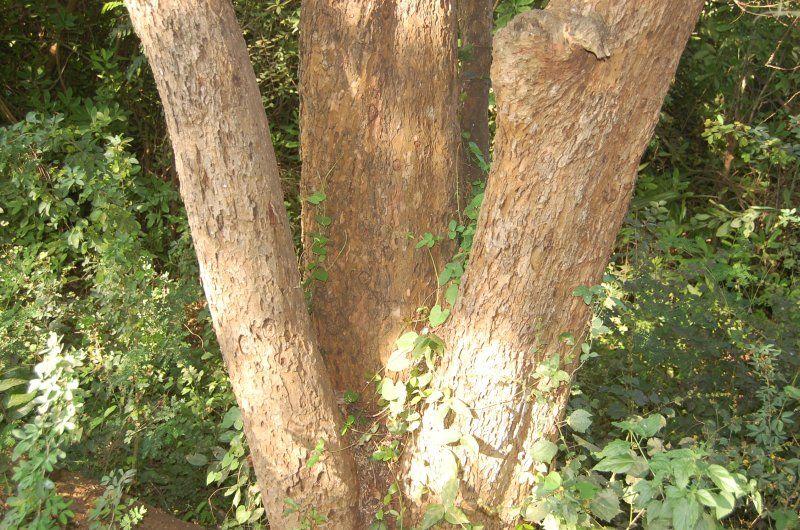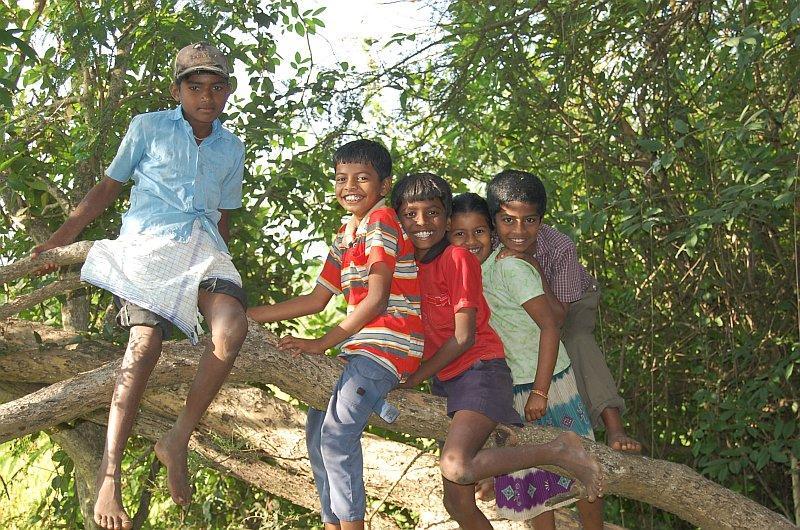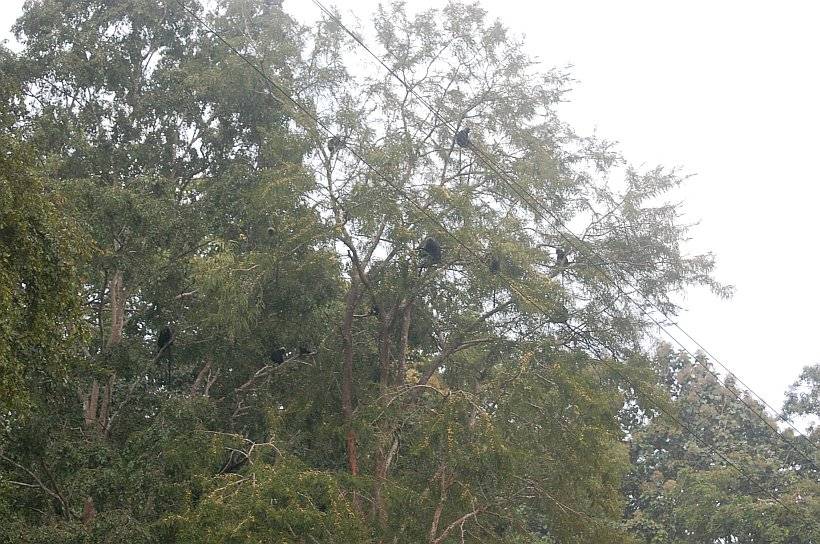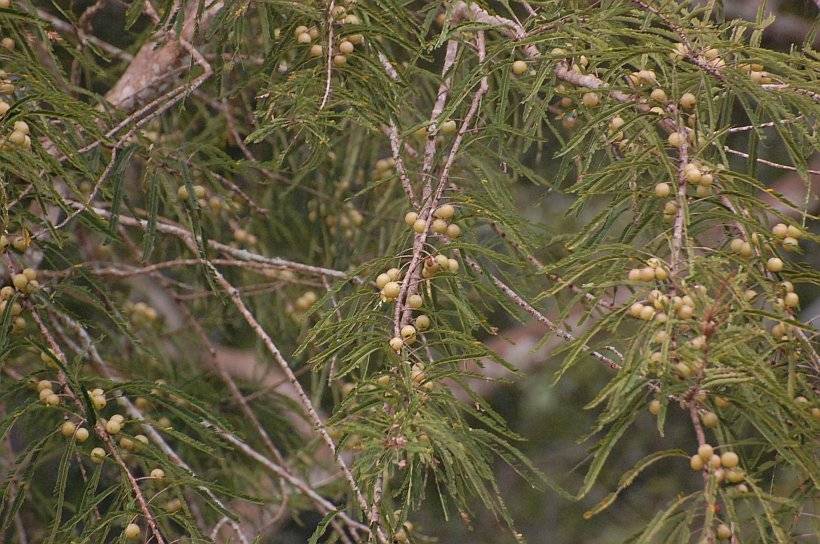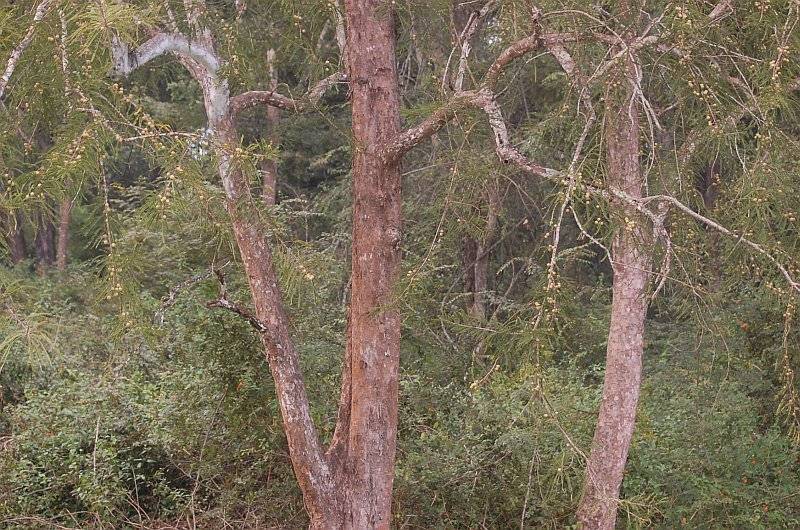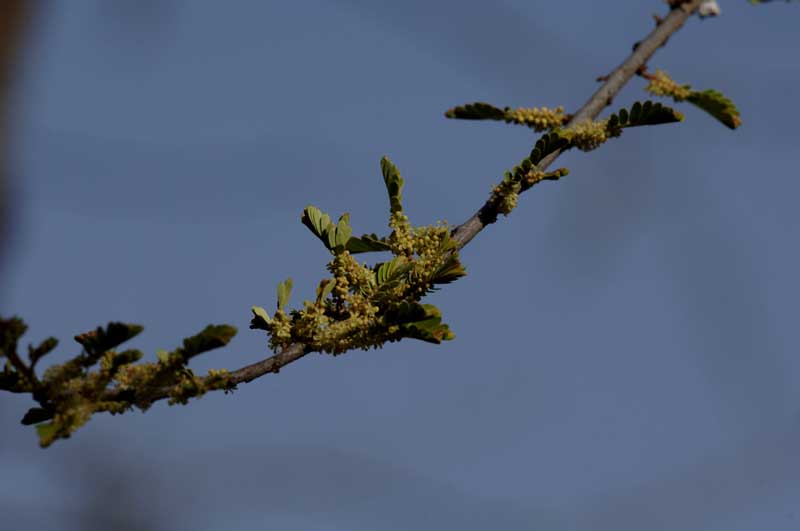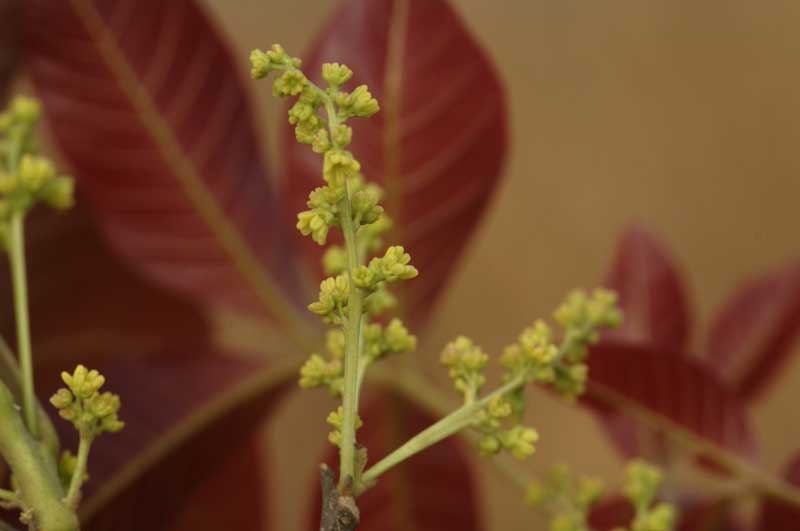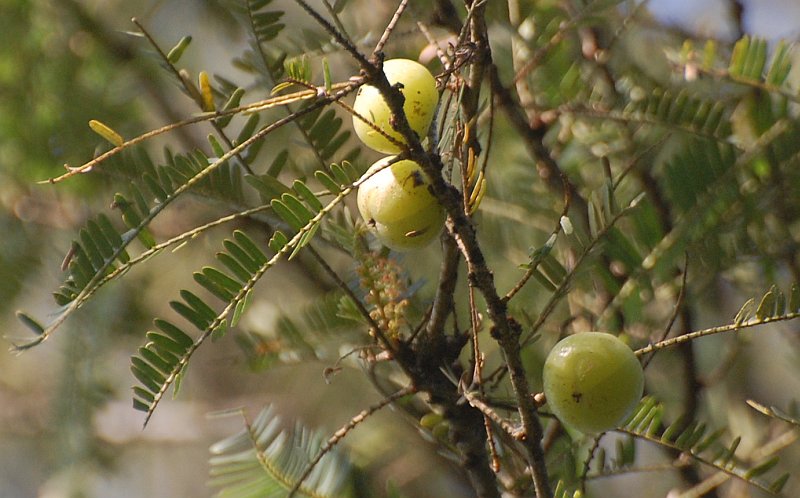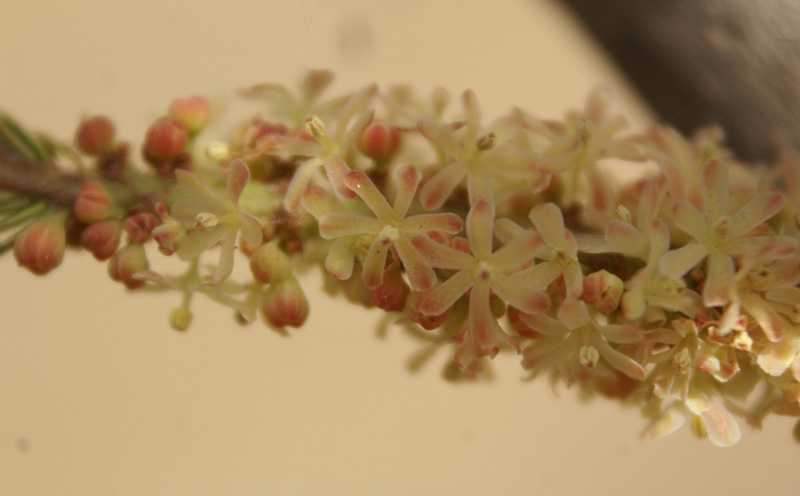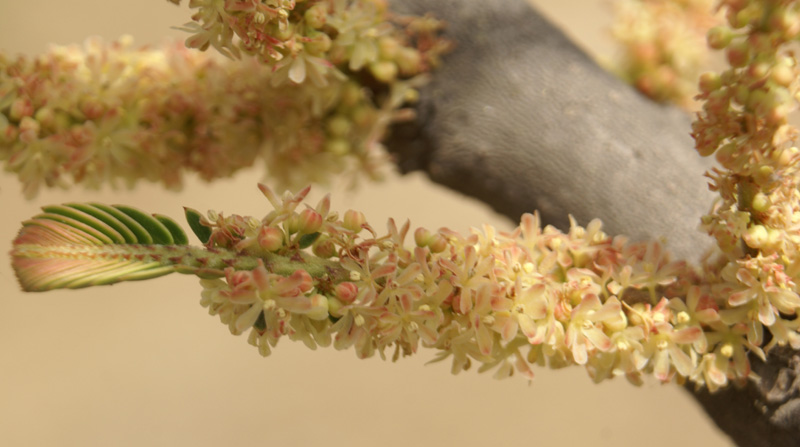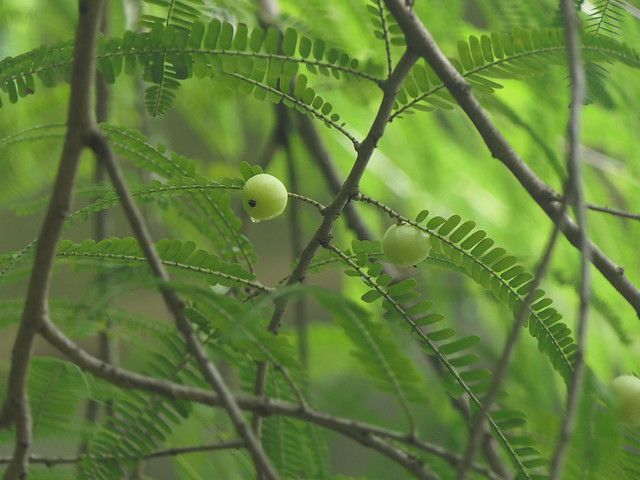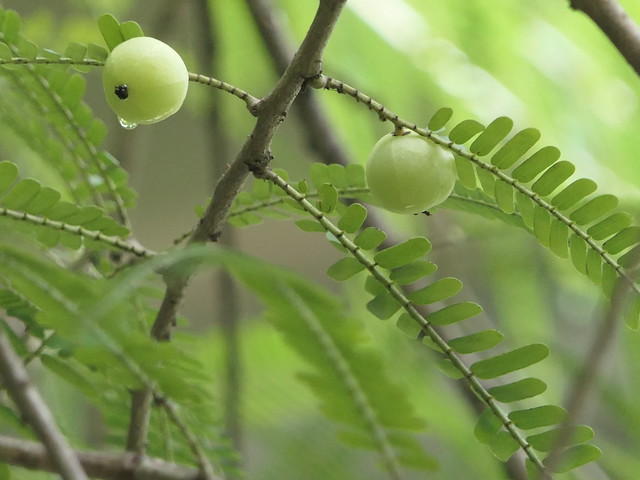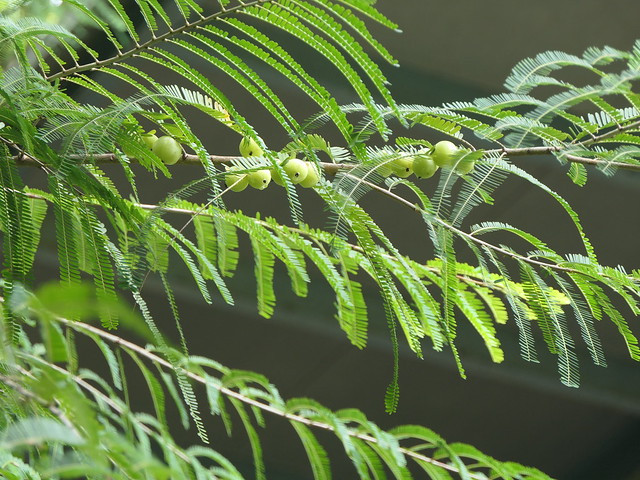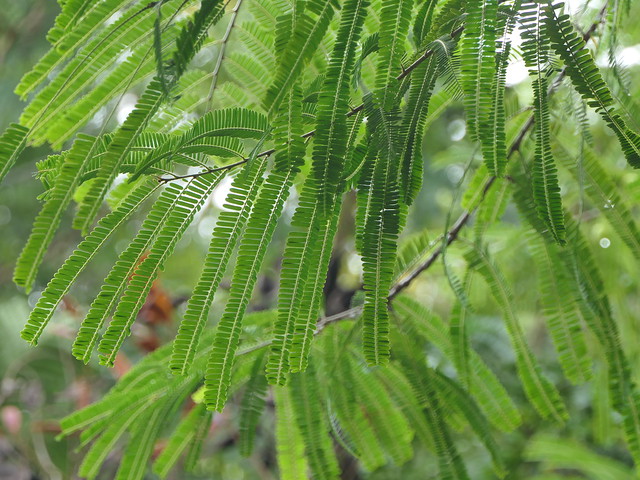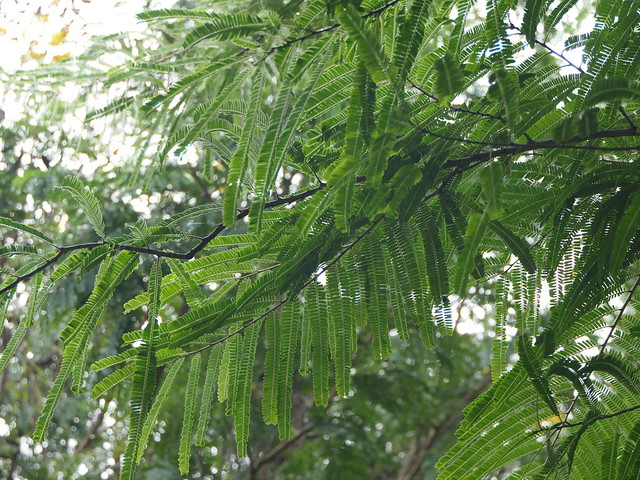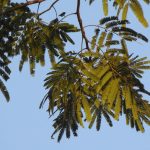|
Phyllanthus emblica L., Sp. Pl. 982 1753. (syn: Ciccaemblica (L.) Kurz; Diasperusemblica (L.) Kuntze; Dichelactinanodicaulis Hance; Emblicaarborea Raf.; Emblicaofficinalis Gaertn.; Phyllanthusglomeratus Roxb. ex Wall.; Phyllanthusmairei H.Lév.; Phyllanthusmimosifolius Salisb.; Phyllanthustaxifolius D.Don);
. Tropical & Subtropical Asia: Assam, Bangladesh, Borneo, Cambodia, China South-Central, China Southeast, East Himalaya, Hainan, India, Jawa, Laos, Lesser Sunda Is., Malaya, Myanmar, Pakistan, Sri Lanka, Sumatera, Taiwan, Thailand, Vietnam, West Himalaya as per POWO; .
emblic myrobalan, Indian gooseberry • Assamese: আম্লখি amlaki • Bengali: আমলকী amlaki • Gujarati: આમળા amla, આમલક amalak • Hindi: आमला amla, आंवला anwla, बहुमूली bahu-muli, ब्रह्मवृक्ष Brahma vriksh • Kannada: ಆಮಲಕ aamalaka, ಬೆಟ್ಟ ನೆಲ್ಲಿ betta nelli, ದೊಡ್ಡ ನೆಲ್ಲಿ dodda nelli • Kashmiri: आमलकी amalaki, ओम्ल omala • Khasi: dieng sohmylleng • Konkani: आवळो avalo • Malayalam: നെല്ലി nelli, നെല്ലിക്ക nellikka • Manipuri: আমলা amla, heikru • Marathi: अवळा avala, आंवळा aanvala • Mizo: sinhlu • Nepalese: अमलो amalo • Oriya: aula • Pali: आमलक amalak • Punjabi: ਆਂਵਲਾ anwala, ਆਉਲਾ aula • Sanskrit: अकर akara, अमलाः amalah, आमलकः amalakah, ब्रह्मवृक्ष Brahmavriksh, धात्रिका dhatrika, मण्डा manda, राधा radha, शंभुप्रिया shambhupriya, शिवा shiva, श्रीफली shriphali, सुधा sudha, तमका tamaka, तिष्या tishya, वज्रम् vajram, विलोमी vilomi • Tamil: ஆமலகி amalaki, அமிர்தபலம் amirta-palam, அத்தகோரம் attakoram, சிரோட்டம் cirottam, சிவை civai, இந்துளி intuli, கந்தாத்திரி kantattiri, காட்டுநெல்லி kattu-nelli, கோங்கம் konkam, கோரங்கம் korankam, நெல்லி nelli, தாத்திரி tattiri, தேசோமந்திரம் tecomantiram, தோப்புநெல்லி toppu-nelli, தோட்டி totti • Telugu: ఆమలకము amalakamu, ధాత్రి dhatri, నెల్లి nelli, ఉసిరి usiri • Urdu: آنولا anwla ;
. fil-LAN-thus — flower leaf; it appears to flower from a leaf like stem EM-blee-kuh — Latinized form of Sanskrit amalakah (sour) oh-fiss-ih-NAH-liss — official; used in pharmacological sense . Native to: s China, India, Indo-China, Malesia; cultivated elsewhere in tropics
.
Fruit is edible as raw or in pickle. A kind of beverages also produced with sugar (fermented) and used during the hot summer in some fringe villages near Manas Tiger Reserve, Assam;
Amlas are great to have in the field, dried, salted and sweetend ones.!!;
The taste of Amla is sour, bitter and astringent, and is quite fibrous. In India, it is common to eat gooseberries with salt and water to make the sour fruits palatable.;
This is one of the ingredients in the famous tonic Triphala churna. Others are Haritaki (Terminalia Chebula) and Bibhitaki (Terminalia Bellerica);
Part used as per the book ‘Nature Heals’ are Plant, Stembark, Leaf, Root, Flower, Fruit, Seed.; Action/Uses: Fruit; refrigerant, diuretic, laxative, acrid, cooling, carmative, stomatichic; Flower and unripe fruit; aperient,vermifuge . Flower; cooling, refrigerant. Root & Stembark; astringent. Used in haemorrhagia, anaemia, jaundice, dropsy, cough, Exudation from incisions of the fruit; external application for inflammation of the eyes. Seeds; asthma, bronchitis, biliousness. .
As per efi thread: Leaves usually 100 or more pairs per branchlet, closely distichous and often overlapping, linear-oblong, 3- 20 x 1 – 5 mm; petioles 0.4 – 1 mm long … 2.P. emblica Leaves up to 50 pairs per branchlet, not closely distichous, not overlapping, only touching each other, oblong, oblong-elliptic to linear-oblong, 10 – 25 x 2 – 10 mm; petioles 1 – 3 mm long … 3. P. indofischeri . Fruit & Vegetable Week- Phyllanthus emblica: – Nellikai — truely a wonderful fruit! – This might be a hybrid cultivar. –NATIVE, WILD, CULTIVATED :: Phyllanthaceae (leaf flower family) » Phyllanthus emblica
Synonyms: Emblica officinalis (popular), Mirobalanus embilica fil-LAN-thus — flower leaf; it appears to flower from a leaf like stem EM-blee-kuh — Latinized form of Sanskrit amalakah (sour) oh-fiss-ih-NAH-liss — official; used in pharmacological sense Native to: s China, India, Indo-China, Malesia; cultivated elsewhere in tropics Edible use: … unripe fruit (as VEGETABLE) … pickled, or added to food preparations, as a substitute for tamarind. … ripe fruits are also eaten. – Here is link to my (only) contribution to Wikipedia, picture of Aonla pickle. Fruits & Vegetables Week: Phyllanthus emblica, the Emblic myrobalan, Amla:
Phyllanthus emblica, the Emblic myrobalan, Indian Gooseberry, or Amla, eaten raw or cooked, pickled, a rich source of Vitamin C, containing 20 times more Vitamin C as compared to orange juice Local names
Sans: Adiphala, dhatri, amalaka Hindi: Amla, amlika, aonla Beng: Amla, amlaki Guj: Amoli, ambala Tel: Amalakamu, usirikai Tam: Nelli Kan: Amalaka, nelli Mal: Nelli Euphorbiaceae Week: Phyllanthaceae, Phyllanthus emblica from Delhi: Phyllanthus emblica L., Sp. pl. 2:982. 1753
syn: Emblica officinalis Gaertn. Mirobalanus embilica Burm. Deciduous tree often planted for its fruits, often used pickled or cooked, a rich source of vit. C Common names: Emblic myrobalan, Indian gooseberry … Part used as per the book ‘Nature Heals’ are Plant, Stembark, Leaf, Root, Flower, Fruit, Seed. – bearing branchlets, often on the naked portion below the leaves, with frimbriate bracts at the base.
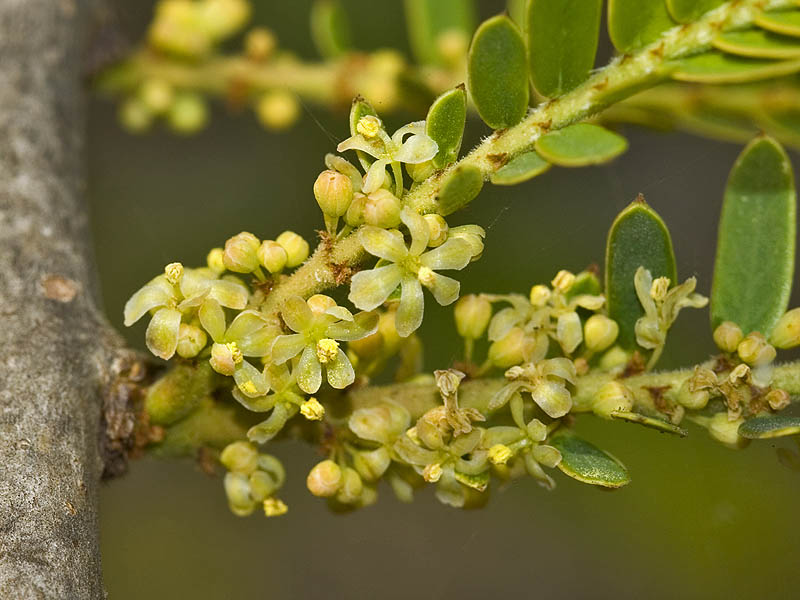 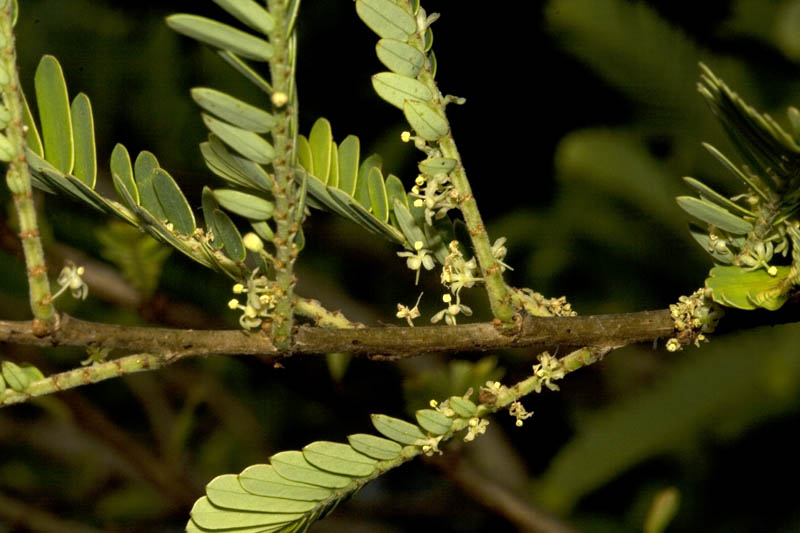 EUPHORBIACEAE WEEK :: Phyllanthus emblica: Though the EUPHORBIACEAE WEEK is over I couldn’t resist posting the good specimen of flowers which I observed yesterday in Smruti Udyan Pune. – If the pictures are so good, keep them coming .., thanks. These are also complementary to the wonderful ones uploaded by Dr. .. last week. Here the fimbriate bracts at the base of flowers are clearly seen and – con·choi·dal: Denoting a type of fracture in a solid (such as flint or quartz) that results in a smooth rounded surface resembling the shape of a scallop shell. .. – Brandis has mentioned for this plant -pg 570 : as ” bark greenish -gray, peeling off in conchoid scales, wood red, hard, med. rays broad, conspicuous on a vertical section“. So the natural fracturing in the wood, bark would lead some sort of scales looking like scallop shell?!! No Sir not hybrid. It was a grafted Banarasi Amla. VALMIKI : OBSERVER OF NATURE 46: Attaching the 46th member of the series. Valmiki mentioned this tree as AMALAKA. It is known as Indian gooseberry or Emblic Myrobalan. Scientifically it is Emblica officinalis. It is Amla in Hindi and Amlaki in Bangla. What a lot of fruits on one short group of branches.. imagine how many would a tree bear? . Flower images of Emblica officinalis:
KAS Week ::(Phyllanthus emblica-05/10/2012-NJ): Nice capture … This is one of the ingredients in the famous tonic Triphala churna. Others are Haritaki (Terminalia Chebula) and Bibhitaki (Terminalia Bellerica) Kaas week :Emblica officinalis: Fruit Trees of Bangalore – RA – Phyllanthus Emblica – Indian Gooseberry Tree – Amla: The leaves are simple, nearly stalkless and closely set along slender branchlets. The leaves are often mistaken for leaflets of pinnate leaves.
The genus name Phyllanthus is derived from Greek words meaning leaf-flower, an allusion to the apparent bearing of flowers on the leaves.
Amla flowers are small, greenish-yellow or pinkish. The flowers have six segments, but no real petals. Male and female flowers are carried separately on the same branch.
The fruit is nearly spherical, light greenish yellow, quite smooth and hard on appearance, with 6 vertical stripes or furrows. Ripening in autumn, the berries are harvested by hand after climbing to upper branches bearing the fruits.
The taste of Amla is sour, bitter and astringent, and is quite fibrous. In India, it is common to eat gooseberries with salt and water to make the sour fruits palatable.
Ref. Phyllanthus emblica – Wikipedia, the free encyclopedia Gorgeous……. Excellent shots. These fruits are best source of Vitamin C Truely I haven’t seen such clear pics of the flowers before (or better to admit I haven’t seen flowers so closely). Special thanks, I will now also try to locate the flowers and shoot them. Wow, this is Nellikka, my favorite. Euphorbiaceae Fortnight : Phyllanthaceae – Phyllanthus emblica, L. <=> Indian Gooseberry Tree – Amla – bangalore – RA : Attachments (10). 3 posts by 3 authors. Link The leaves are simple, nearly stalkless and closely set along slender branchlets. The leaves are often mistaken for leaflets of pinnate leaves.
The genus name Phyllanthus is derived from Greek words meaning leaf-flower, an allusion to the apparent bearing of flowers on the leaves.
Amla flowers are small, greenish-yellow or pinkish. The flowers have six segments, but no real petals. Male and female flowers are carried separately on the same branch.
The fruit is nearly spherical, light greenish yellow, quite smooth and hard on appearance, with 6 vertical stripes or furrows. Ripening in autumn, the berries are harvested by hand after climbing to upper branches bearing the fruits.
The taste of Amla is sour, bitter and astringent, and is quite fibrous. In India, it is common to eat gooseberries with salt and water to make the sour fruits palatable. Nice detailed display … Euphorbiaceae fortnight :: Phyllanthaceae :: Phyllanthus emblica at Tungareshwar WLS :: DV63 : 8 images. 3 posts by 2 authors. Phyllanthus emblica L. … Phyllanthaceae, Euphorbiaceae s. l.
at Tungareshwar Wildlife Sanctuary on 20 MAR 10
at Burondi on 12 APR 09 along Pasarani Ghat on 25 AUG 10 Euphorbiaceae fortnight :: Phyllanthaceae :: Phyllanthus emblica from Coimbatore BRS 002 : Attachments (4). 2 posts by 2 authors. .
Euphorbiaceae Fortnight : 07112013 ARK-31 : Phyllanthus emblica from Mumbai and Almora: Attachments (2). 2 posts by 2 authors. Attached are pictures of Phyllanthus emblica from Jijamata Udyan, Mumbai i March 2013 and from Almora in November 2012 Correct only. EUPHORBIACEAE FORTNIGHT: Phyllanthus emblica from Uttarakhand_DSR_43 : Attachments (1). 3 posts by 3 authors.
Phyllanthus emblica L. is a cultivated fruit in Pantnagar. Several varieties of it are planted here. Wild plants exist in adjacent forests and in hills but the fruits are smaller in those. Yes, I agree. EUPHORBIACEAE FORTNIGHT:: Phyllanthus emblica from Panipat NS-27 : Attachments (6). 2 posts by 2 authors.
This was shot from Panipat.. was growing on a private property..
world famous for medicinal and culinary uses.. Excellent photos, Sir. EUPHORBIACEAE FORTNIGHT :: Emblica officinalis Pune :: SMP 9 : 2 images. 2 posts by 2 authors.
Emblica officinalis
The Amla tree flowers. आवळा in Marathi. Why do you use the old name. It is Phyllanthus emblica. Euphorbiaceae Fortnight : Phyllanthaceae : Phyllanthus emblica : Delhi & Mumbai : 111113 : AK-79 : Attachments (3). 2 posts by 2 authors.
Phyllanthus emblica, commonly known as Indian Gooseberry, from Delhi & Mumbai. One of the commonest species in India. .
Euphorbiaceae Fortnight: Phyllanthaceae, Phyllanthus emblica from Delhi-GS-64 : 4 images. 2 posts by 2 authors. Phyllanthus emblica L., Sp. pl. 2:982. 1753
syn: Emblica officinalis Gaertn.
Mirobalanus embilica Burm.
Deciduous tree often planted for its fruits, often used pickled or cooked, a rich source of vit. C
Common names: Emblic myrobalan, Indian gooseberry
Hindi: Amla, amlika, aonla
Beng: Amla, Amlaki
Guj: Amoli, ambala
Tel: Amalakamu, usirikai
Tam: Nelli
Mal: Nelli
Euphorbiaceae fortnight::Amla – Phyllanthus emblica (NSJ-05) : Attachments (1). 2 posts by 2 authors. Phyllanthus emblica. EUPHORBIACEAE FORTNIGHT : Phyllanthaceae : RVS-12 : 2 images. 7 posts by 6 authors.
Phyllanthus emblica L.
Collected from: Bangalore, KA. One more excellent presentation.  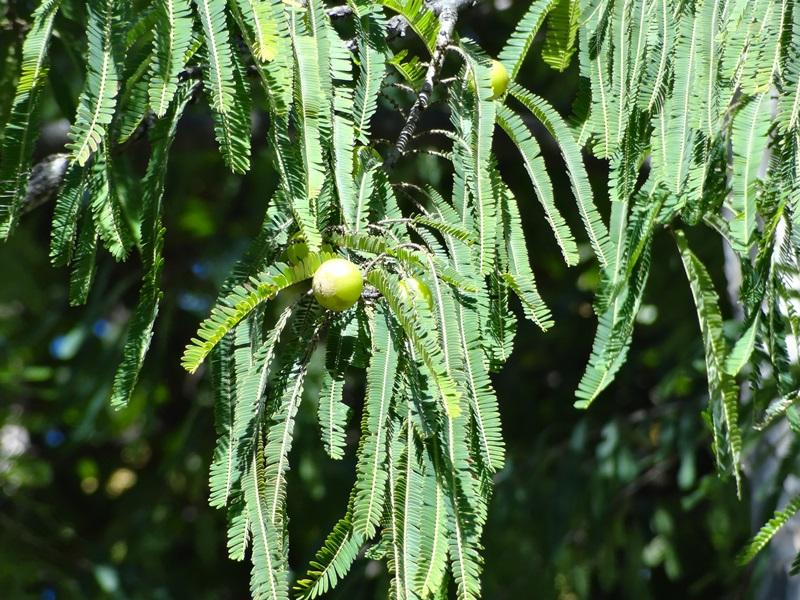 Euphorbiaceae Fortnight : 07112013 ARK-31 : Phyllanthus emblica from Mumbai and Almora: Attachments (2). 3 posts by 2 authors. Attached are pictures of Phyllanthus emblica from Jijamata Udyan, Mumbai in March 2013 and from Almora in November 2012 Correct only. PLANTS MENTIONED BY RABINDRA NATH TAGORE IN SONGS : AMLAKI-1 : 1 post by 1 author. Attachments (1)
I was working on the plants mentioned by poet Tagore in his songs, for last one and half years. It is interesting to note that poet has mentioned some 83 plants in his songs. Top 5 are as under, 1. BAKUL – 69
2. SHIULI – 38
3. MALATI- 34
4. CHNAPA- 29
5. KADAM -27
I have uploaded some 513 songs (some are repetition, as different plants are mentioned in the same song ) for my friends who can read and understand Bangla. With the guidance of my young friend Prof. Sankalpa Ghosh (IIT, Delhi) I am in the process of incorporating the English translation of the songs where plants are mentioned. Attaching an image of AMLAKI (Emblica officinalis/ AMLA/ INDIAN GOOSEBERRY) with translation of a song printed on it.
FLOWERS/PLANTS MENTIONED BY TAGORE IN HIS SONGS ( AMLAKI-1 ) : 1 post by 1 author. Attachments (1)
TSP-JAN2016-34-34:Images of Phyllanthus emblica (Phyllanthaceae) : 1 post by 1 author. Attachments (7) It is my pleasure to share few images of Phyllanthus emblica (Phyllanthaceae) Habit: Tree Habitat: Wild- Cultivated Sighting: Chikmagalur and Tumkur, Karnataka about 1000msl and 800 msl respectively Date: 27-05-2014, 06-07-2014, 07-09-2014, 22-09-2014, 07-02-2015, 19-02-2015 and 25-02-2015 Fwd: SYMBIOSIS : 1055 : 1 post by 1 author. Attachments (1) Phyllanthus emblica AT APL 2018/08 : 4 posts by 2 authors. Attachments (1)
AMLA (Indian Gooseberry) Female flower
Botanical Name: Phyllanthus emblica Place: Dr. P.N. Mehra Botanical Garden, Panjab University, Chandigarh on 3rd April 2018 Based on information available on WebMD (https://www.webmd.com/ …/ingredientmono-784-indian%20goosebe… ), Amla has following health benefits: 1. High cholesterol. Some early research shows that taking Indian gooseberry for 4 weeks decreases low-density lipoprotein (LDL, or “bad”) cholesterol in people with high cholesterol. Other early research shows that taking Indian gooseberry extract for 12 weeks decreases LDL cholesterol in obese people. 2. Osteoarthritis. Research shows that taking two capsules of an Ayurvedic formula containing Indian gooseberry and several other ingredients three times daily for 24 weeks is as beneficial as taking glucosamine sulfate or the drug celecoxib for reducing pain in people with knee osteoarthritis. 3. Skin disorder that causes unpigmented skin (vitiligo). Early research suggests that taking one tablet containing Indian gooseberry and other ingredients three times daily for 6 months along with standard treatment can increase skin repigmentation and reduce signs of inflammation better than standard treatment alone. 4. Bloody diarrhea (dysentery). 5. Cancer. 6. Diabetes. 7. Diarrhea. 8. Eye problems. 9. Hardening of the arteries (atherosclerosis). 10. Indigestion. 11. Joint pain. 12. Obesity. 13. Swelling of the pancreas. Male Flowers
In the shade of an old gooseberry tree. – efloraofindia | Google Groups
Phyllanthus emblica from Delhi – efloraofindia | Google Groups DV – 20MAR10 – 1121 – efloraofindia | Google Groups Indian gooseberry tree.. a feast for the …. Nilgiri langurs ! – indiantreepix | Google Groups A rich haul from kumara paravatha trek – indiantreepix | Google Groups Amalaki – Sustainer of health: A holy herb – indiantreepix | Google Groups Emblica officinalis – efloraofindia | Google Groups For Id 030708JM – indiantreepix | Google Groups Kusum flower – indiantreepix | Google Groups NATIVE :: Phyllanthaceae (leaf flower family) » Phyllanthus emblica – efloraofindia | Google Groups Phyllanthus emblica :: Puducherry :: 16 OCT 19 : 4 posts by 3 authors. 5 images. Awesome. Nellikayi, Nellikayi , Bettanallikayi, Bettada Nellikayi. Common in South India, especially in Mysore district. Fruits of good quality are available in the veg marked almost throughout the year. Most useful medicinal FRUIT. Also known as ‘One fruit pharamacy”, very rich in vitamin ‘C’ and used in Triphala preparation. Request for identification.
Date: 26th June 2020
Time: 1619 hrs
Location- Eco-park, Bilaspur, Himachal Pradesh
Habitat- Wild, on the side of the nature trail/track (maybe planted).
Phyllanthus emblica Taju 01 Nov 20: 2 correct images as above.
Need id of this 45 to 50 feet tall tree in public garden at Agra, U.P
Image:- Nov 20 Parkia biglandulosa I agree with … I think Phyllanthus emblica as per images and details herein.
I think leaves are of Phyllanthus emblica , a small tree on the right side in the 2nd image. . Phyllanthaceae: Phyllanthus emblica L.:
synonym: Emblica officinalis Gaertn. location/date: Jabalpur Distr., Madhya Pradesh, October 1994 . |
Phyllanthus emblica
Updated on July 17, 2025

